There are 40 good Companion plants for Bell peppers in this list, along with 5 bad ones, ranging from alliums, flowers, and fruits to vegetables, making it a fact that bell peppers are a great plant to add to your garden.
Bell peppers, also known as sweet peppers, are the crunchy and colorful stars of the vegetable world. They’re a hit in gardens across the globe, and with good reason! These warm-season crops are part of the nightshade family and come in a rainbow of shades, including green, red, yellow, and orange. Bell pepper plants grow up to 3 feet tall and wide and boast glossy green leaves and a sturdy stem that’ll keep those sweet peppers upright and thriving.
But let’s get to the juicy stuff: Bell peppers aren’t just tasty. They’re also loaded with nutrients, fiber, vitamins, and antioxidants. You can munch on these veggies raw, toss them in a salad, or cook them up in a stir-fry. Trust us; they add a sweet and satisfying crunch to just about any dish! When growing bell peppers, keep in mind that they like their soil well-drained, rich in organic matter, and plenty of sunshine. You don’t want them to get too chilly, so wait until the frost threat has passed before planting them. Water your bell pepper plants regularly, especially when the weather’s dry and hot, to prevent fruit from cracking.
Now, here’s the real fun part: Bell peppers make great companions for other veggies! They attract good-for-your-garden insects, like ladybugs and lacewings, that keep pesky critters at bay, such as aphids and spider mites. You can also plant these babies near herbs like basil and Parsley to enhance their flavor and keep away any unwanted visitors. But be warned: Bell peppers aren’t without their challenges. They can be prone to pest infestations and diseases, like flea beetles, hornworms, and blossom end rot. You can combat these issues by planting your bell peppers in healthy soil, regularly rotating your crops, and keeping your garden tidy, but if you have been doing this already, then you should definitely try companion planting out.
So in this article, we will be looking into Forty (40) Good companion plants and Five (5) Bad Companion plants for Bell peppers and the reasons why you should or should not plant them with Bell peppers, whichever the case might be.
Table of Contents
Good Companion Plants For Bell Peppers
Alliums
1.Chives

- Botanical name: Allium schoenoprasum
- Sun Requirements: 6-8 hours of full sun per day
- Soil Type: Well-drained soil, rich in organic matter
Chives, an onion family member, grow up to 50 centimeters tall and possess a unique flavor that can enhance soups and stews. These ornamental plants also add a touch of beauty to gardens with their pink or purple flowers that bloom in late spring or early summer.
Companion planting is all the rage in gardening circles these days. And it’s easy to see why! By planting different plants together, you can boost your garden’s growth, yield, and pest control. For instance, did you know that chives make excellent companion plants for bell peppers?
Chives are an herb from the Allium family that grow low to the ground, making them easy to grow alongside your bell peppers. And they offer plenty of benefits beyond just pest control! For starters, chives can help improve the soil quality around your bell pepper plants. Their shallow root system can break up compacted soil, allowing for better water and nutrient absorption. Plus, chives are nitrogen-rich, which is essential for healthy plant growth.
But that’s not all! Chives also act as natural fungicides, protecting your bell pepper plants from soil-borne diseases. Their sulfur compounds can inhibit the growth of harmful fungi and bacteria, promoting overall plant health.
And let’s not forget about pest control. Chives contain compounds that can help repel aphids, spider mites, and thrips – all of which can wreak havoc on your bell pepper plants. By planting chives alongside your bell peppers, you can reduce the risk of pest infestation and ensure your plants remain healthy and productive.
So if you’re looking to boost your garden this season, consider planting some chives alongside your bell peppers. Your plants will thank you for it!
2.Garlic
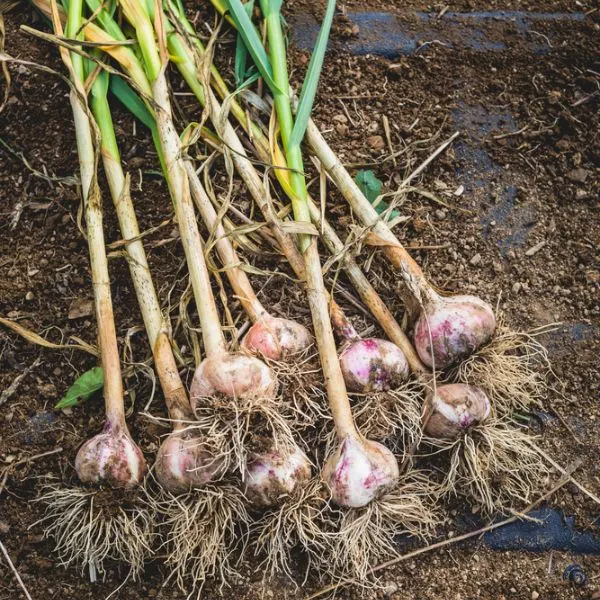
- Botanical name: Allium sativum
- Sun Requirements: 6-8 hours of full sun per day
- Soil Type: Well-drained soil, rich in organic matter
Garlic, a pungent herb from the Allium family, is well-known for its health benefits and culinary uses. It thrives in well-draining soil that receives plenty of sunlight and can be harvested in late summer or early fall. The presence of garlic can deter pests and diseases, making it a fantastic companion plant for many vegetables.
Hey there, garlic lovers! Did you know that your favorite herb can be more than just a flavor booster in your dishes? When grown alongside bell peppers, garlic can offer some serious benefits to your garden. Here’s why:
First off, garlic can help keep those pesky pests at bay. Aphids, spider mites, and whiteflies can be a nightmare for bell pepper plants, but garlic compounds like allicin can act as a natural repellent, reducing the risk of infestation.
But that’s not all! Garlic’s deep root system can also help improve soil quality, breaking up compacted soil and allowing for better absorption of water and nutrients. Plus, its high sulfur content can provide a much-needed nutrient boost for your bell pepper plants.
And if that’s not enough, garlic can also act as a natural fungicide, helping to protect your bell peppers from soil-borne diseases. And when used in cooking, garlic can enhance the flavor of your bell peppers, creating some delicious dishes!
So there you have it, folks. Growing garlic alongside your bell peppers can improve pest control, soil quality, disease prevention, and even flavor. It’s a win-win situation for both plants and your taste buds! So why not give it a try and add some garlic to your garden today?
3. Leeks
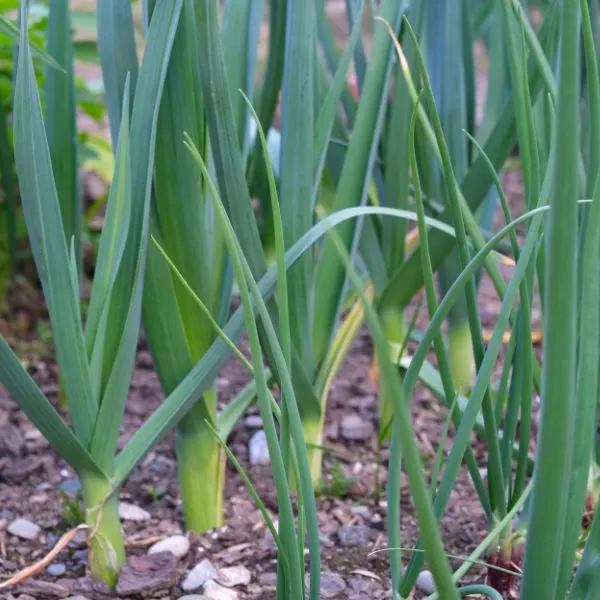
- Botanical name: Allium porrum
- Sun Requirements: 6-8 hours of full sun per day
- Soil Type: Well-drained soil, rich in organic matter
Leeks, closely related to onions and garlic, are appreciated for their mild and sweet flavor, perfect for soups and stews. These resilient plants can grow in various soil types and add an unconventional dimension to gardens with their upright green leaves.
Companion planting is becoming more popular, and one such pairing gaining attention is leeks and bell peppers. While they may seem like an odd couple, planting them together can create a beneficial relationship. They complement each other’s nutrient needs, with leeks acting as heavy feeders and bell peppers having a shallower root system. Leeks also contain a natural insect repellent that can help to keep pests at bay, which is beneficial for susceptible bell peppers. Additionally, leeks provide shade and shelter for the bell peppers and maximize garden space by allowing the shallow-rooted bell peppers to be planted closer together. This unlikely pairing is a great way to support each other’s growth and health, so why not try planting them together in your garden?
4. Onions
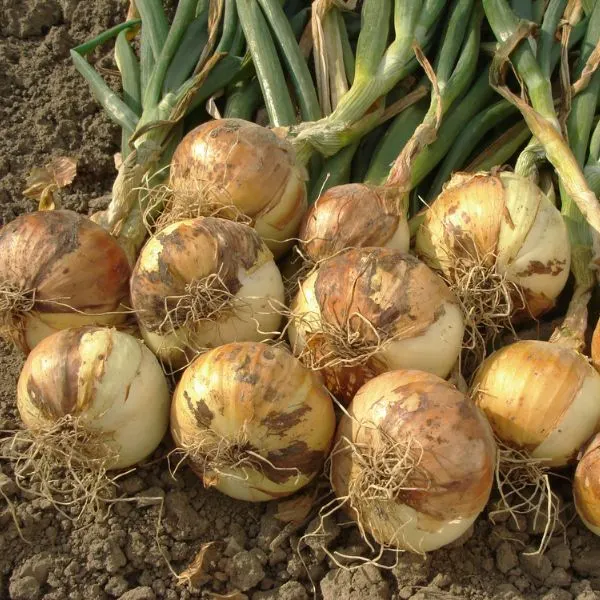
- Botanical name: Allium cepa
- Sun Requirements: 6-8 hours of full sun per day
- Soil Type: Well-drained soil, rich in organic matter
Onions are a versatile and indispensable vegetable that adds flavor to a wide range of dishes, including salads, soups, and stews. They flourish in full sun and well-draining soil, and you can harvest them when their leaves turn yellow and begin to fall over.
Onions are more than just a tasty ingredient in your meals; they can also offer significant benefits to other plants when grown together. Bell peppers, for example, can benefit from the addition of onions as a companion plant. Companion planting can offer many benefits beyond pest control.
Onions have several benefits as a companion plant for bell peppers. They can help repel pests such as aphids, thrips, and mites. Onions contain compounds like sulfur and quercetin that can deter these pesky insects, which can cause significant damage to bell pepper plants. Additionally, onions can help improve soil quality by breaking up compacted soil, allowing for better water and nutrient absorption. Onions are also rich in nitrogen, which is crucial for plant growth. When onions are grown alongside bell peppers, they can help increase the soil’s nitrogen content, promoting healthy plant growth. Furthermore, onions are a natural fungicide that helps protect bell pepper plants from soil-borne diseases.
In conclusion, planting onions as a companion plant for bell peppers can offer several benefits, including pest control, soil improvement, disease prevention, and enhanced flavor. By growing these two plants together, you can create a mutually beneficial relationship that can enhance the health and productivity of your garden.
5. Scallions
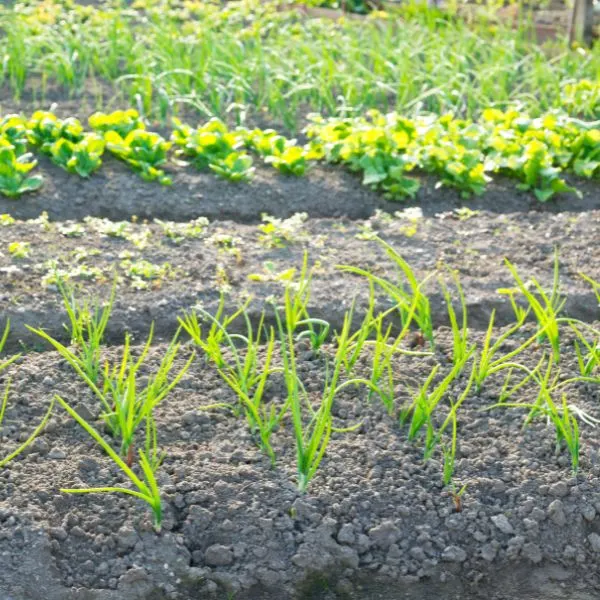
- Botanical name: Allium fistulosum
- Sun Requirements: 6-8 hours of full sun per day
- Soil Type: Well-drained soil, rich in organic matter
Scallions, or green onions, are a type of onion frequently used in salads and as a garnish. These plants can be grown easily from seed or bulbs and prosper in full sun and well-draining soil.
Companion planting has been used for centuries to grow healthy and productive gardens. When growing bell peppers, planting scallions, or green onions, as a companion plant can provide many benefits. Scallions and bell peppers create a symbiotic relationship that can help to improve the health and productivity of your garden.
Scallions can help to repel pests such as aphids, spider mites, and thrips, which can often damage bell peppers. They also improve soil quality by being heavy feeders and can loosen the soil, making it easier for bell peppers to absorb nutrients. Additionally, scallions have shallow roots and can help to conserve moisture in the soil, which can be beneficial in hot and dry climates. They also provide shade to protect bell peppers from intense sunlight and can be planted in between the rows of bell peppers to maximize garden space. By planting scallions and bell peppers together, you can create a harmonious relationship that benefits both plants and helps you grow a healthy and productive garden.
If you want to FLOWERS with your Bell peppers, then these flowers are your best choices:
6. Alyssum
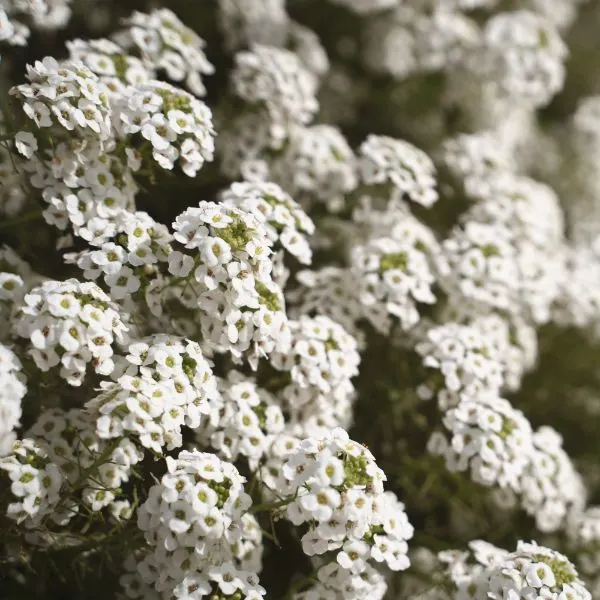
- Botanical name: Alyssum spp.
- Sun Requirements: 4-6 hours of full sun per day
- Soil Type: Well-drained soil, moderate fertility
Alyssum, a low-growing flowering plant, emanates a delicate aroma and adds an elegant touch to gardens. Its clusters of small white or pink flowers bloom from spring to summer and are often used as a border or ground cover plant.
Are you looking to grow healthy and productive bell pepper plants? Then consider using alyssum as a companion plant! Companion planting is a gardening technique that involves planting different species of plants together to support each other’s growth and health. Alyssum, in particular, can offer several benefits that go beyond just pest control.
One of the significant advantages of using alyssum as a companion plant for bell peppers is its ability to attract beneficial insects. This sweet-scented plant can attract pollinators like bees and butterflies, which can help promote healthy growth and increase yield. Alyssum can also help control pest populations by attracting ladybugs and lacewings, which can eat harmful insects like aphids and mites.
In addition to pest control, alyssum can also help improve soil quality, regulate soil moisture and temperature, and add a beautiful pop of color to your garden. It has a deep root system that can break up compacted soil and increase nitrogen content. When grown as a ground cover, alyssum can help prevent moisture loss and maintain cooler soil temperatures, which can benefit bell pepper plants that prefer consistent moisture levels and cooler soil temperatures. With its delicate flowers, alyssum can also create a beautiful contrast against the bright green foliage of bell pepper plants, making your garden not only functional but also visually appealing.
In conclusion, planting alyssum alongside your bell peppers can create a harmonious relationship that can enhance the health and productivity of your garden. So, why not give it a try? By using alyssum as a companion plant, you can improve soil quality, regulate moisture and temperature, attract beneficial insects, and add a beautiful touch to your garden design.
7. Borage
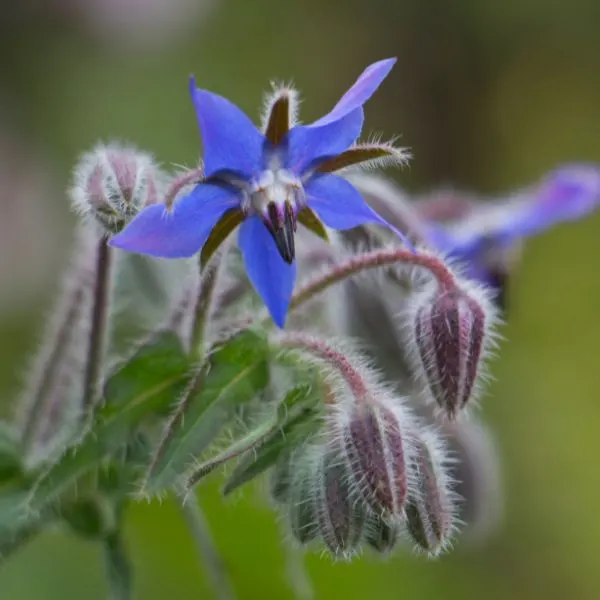
- Botanical name: Borago officinalis
- Sun Requirements: 6-8 hours of full sun per day
- Soil Type: Well-drained soil, moderate fertility
Borage, a flexible and attractive plant, is frequently cultivated in herb gardens and utilized as a companion plant. Its vibrant blue flowers are appealing to pollinators, and its leaves can be used in salads or as a garnish.
If you’re looking to grow bell peppers, choosing the right companion plants is key to their success. Borage, a plant also known as starflower, is one such plant that can be a game-changer for your garden. This annual herb is not only known for its medicinal properties, but it can also help improve the health and productivity of your garden.
One of the most significant benefits of growing borage alongside bell peppers is its ability to attract pollinators. Borage produces beautiful blue flowers that are a magnet for bees and other beneficial insects. By attracting these pollinators, borage can help to increase the yield and quality of your bell pepper harvest. Borage is also a nutrient accumulator, making it an excellent choice for improving soil quality. It has a deep taproot that can mine minerals and nutrients from deep within the soil, which is then made available to the surrounding plants, such as bell peppers, through the decomposition of borage’s leaves and roots. Additionally, borage can help repel pests such as tomato hornworms, cabbage worms, and other caterpillars that can damage your bell pepper plants. Its deep root system can access water from deeper in the soil, making it better able to withstand periods of drought or low rainfall. Finally, borage can help to create a microclimate in your garden that can benefit your bell pepper plants, protecting them from the heat and dryness that can come with direct sunlight.
In conclusion, planting borage alongside your bell peppers can create a symbiotic relationship that can help you grow a healthier and more productive garden. Borage can attract pollinators, improve soil quality, repel pests, increase drought tolerance, and create a microclimate that can benefit your bell pepper plants. So, give borage a try as a companion plant for your bell peppers and see the difference it can make in your garden!
8. Calendula

- Botanical name: Calendula officinalis
- Sun Requirements: 6-8 hours of full sun per day
- Soil Type: Well-drained soil, moderate fertility
Calendula, also known as pot marigold, is a vibrant and cheerful flower that blooms in a variety of colors from yellow to orange to red. It’s often utilized in medicinal salves and creams, and its petals can also be eaten in salads or as a garnish.
Companion planting can have many benefits, and one plant that can be a great companion for bell peppers is calendula, also known as pot marigold. Calendula is not only a beautiful flower, but it can also attract beneficial insects such as bees and butterflies that are essential for pollinating bell peppers. These insects can also help control harmful pests like aphids and mites, which can damage your bell pepper plants.
Calendula can also act as a natural pest repellent for bell peppers due to its pungent odor, which can repel pests like whiteflies, spider mites, and aphids. Moreover, calendula can improve soil quality by breaking up compacted soil and increasing nitrogen content, which is essential for plant growth. Additionally, calendula has medicinal properties that can be used to treat minor skin irritations like cuts, bruises, and burns, as well as digestive issues like ulcers and gastritis.
In conclusion, planting calendula alongside bell peppers can have numerous benefits, such as pest control, soil improvement, pollination, and medicinal properties. So, if you want to create a functional and beautiful garden that can enhance the health and productivity of your bell pepper plants, consider planting some calendula alongside your bell peppers today!
9. Coneflowers
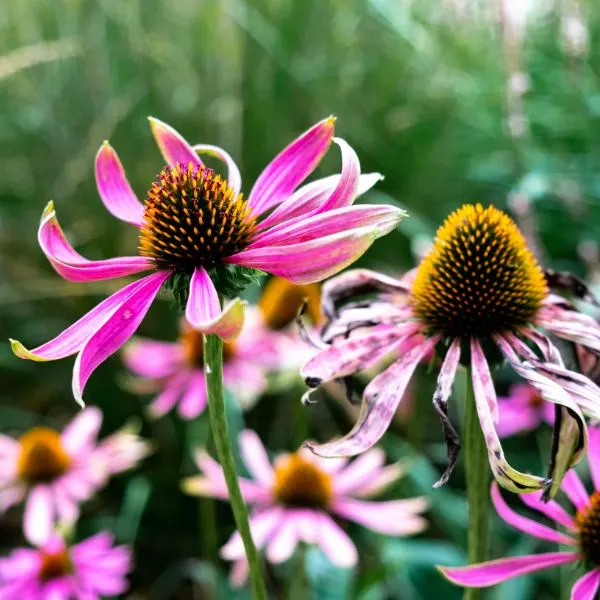
- Botanical name: Echinacea purpurea
- Sun Requirements: 6-8 hours of full sun per day
- Soil Type: Well-drained soil, moderate fertility
Coneflower, also known as Echinacea, is a stunning and durable perennial that brings a splash of color to gardens. Its unique petals encircle a central cone, and it blooms from summer to fall. Coneflower is beloved by pollinators and has medicinal properties that make it a favorite among many.
Coneflower, also known as Echinacea, is a stunning and durable perennial that brings a splash of color to gardens. Its unique petals encircle a central cone, and it blooms from summer to fall. Coneflower is beloved by pollinators and has medicinal properties that make it a favorite among many.
Are you ready to learn about another fantastic companion plant for bell peppers? Look no further than the beautiful and hardy coneflower! These native North American plants, also known as Echinacea, have been used for centuries for their medicinal properties. But did you know that they can also provide numerous benefits to your bell pepper plants?
One of the most significant advantages of growing coneflowers alongside your bell peppers is their ability to attract beneficial insects. Coneflowers produce beautiful, daisy-like flowers that are a favorite of bees, butterflies, and other pollinators. By attracting these beneficial insects, coneflowers can help to increase the yield and quality of your bell pepper harvest.
But the benefits of coneflowers don’t stop there. These hardy plants are also known for their ability to improve the overall health of your garden. They have deep taproots that can help to loosen compacted soil, improve drainage, and increase nutrient availability. By improving soil quality, coneflowers can help your bell pepper plants to grow healthier and more productive.
Coneflowers can also act as a natural pest repellent, thanks to their ability to produce natural chemicals that repel certain insect pests. These chemicals can help to deter pests such as aphids, spider mites, and Japanese beetles, which can cause damage to your bell pepper plants.
In addition to their pest-repelling properties, coneflowers can also help to improve the drought tolerance of your bell pepper plants. Their deep root system can access water from deeper in the soil, which means that they are better able to withstand periods of drought or low rainfall. This can be especially beneficial if you live in an area with limited water resources.
Finally, coneflowers can add beauty and interest to your garden. With their colorful flowers and unique seed heads, they can provide an eye-catching backdrop for your bell pepper plants. Plus, they are incredibly easy to care for, making them an ideal choice for busy gardeners.
In conclusion, coneflowers can offer a range of benefits to your bell pepper plants. They can attract beneficial insects, improve soil quality, repel pests, increase drought tolerance, and add beauty to your garden. By planting coneflowers alongside your bell peppers, you can create a harmonious and mutually beneficial relationship that can help you to grow a healthier and more productive garden.
10. Cornflowers
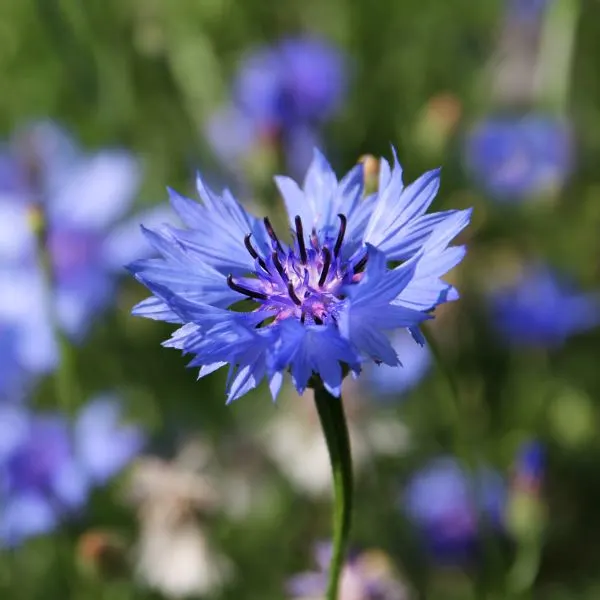
- Botanical name: Centaurea cyanus
- Sun Requirements: 6-8 hours of full sun per day
- Soil Type: Well-drained soil, moderate fertility
Cornflower also called Bachelor’s Button, is an exquisite and easy-to-grow annual that blooms in a range of colors from blue to pink to white. It’s often used as a cut flower or in dried arrangements.
If you’re a fan of bell peppers, you might be interested to know that planting cornflowers alongside them can offer some pretty impressive benefits. For one, cornflowers are attractive to pollinators like bees and butterflies, which can help increase pollination and improve yield. And who doesn’t want more peppers, right?
But that’s not all. Cornflowers also have a scent that pests like aphids and spider mites find unappealing. By planting them next to your bell peppers, they can help keep these pests at bay and reduce the chances of infestations. Plus, cornflowers are known to be a good source of nutrients, which can help improve soil health and give your peppers the nutrients they need to grow big and strong.
But wait, there’s more! Cornflowers can also grow tall and provide some much-needed shade for your bell peppers in hot climates where they might be at risk of sunburn. And let’s be honest, who doesn’t love a little shade on a hot day? Overall, planting cornflowers as a companion to your bell peppers can help increase yield, repel pests, improve soil health, and provide some much-needed shade. What’s not to love?
11. Cosmos
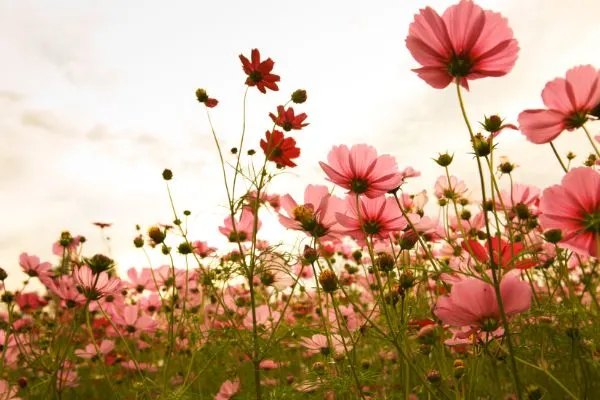
- Botanical name: Cosmos bipinnatus
- Sun Requirements: 6-8 hours of full sun per day
- Soil Type: Well-drained soil, moderate fertility
Cosmos, a charming and easy-to-grow annual, produces daisy-like flowers in shades of pink, white, and purple. It’s a fantastic addition to any garden and blooms from mid-summer to early fall.
Are you looking for a way to beautify your garden while also boosting the health and productivity of your bell pepper plants? Consider planting some cosmos! This flowering plant comes in a variety of stunning colors and shapes and offers several benefits as a companion plant for bell peppers.
One of the main advantages of planting cosmos alongside bell peppers is its ability to attract pollinators like bees and butterflies. The pollination process is essential for fruit formation in bell peppers, and having the cosmos nearby can help ensure that your plants have plenty of pollinators to get the job done. Additionally, the cosmos can also act as a natural pest repellent by deterring harmful insects with its strong scent and attracting beneficial insects like ladybugs and lacewings that eat pests.
But that’s not all. Cosmos can also help improve soil quality around your bell pepper plants by breaking up compacted soil and increasing the nitrogen content of the soil. This essential nutrient is crucial for plant growth, and having cosmos growing alongside your bell peppers can help ensure they have access to it. And on top of all these benefits, cosmos can add a pop of color and texture to your garden, creating a visually stunning space that promotes the health and productivity of your bell pepper plants.
In conclusion, planting cosmos alongside bell peppers can offer numerous benefits, including pollination, pest control, soil improvement, and aesthetic appeal. By incorporating this beautiful flowering plant into your garden, you can create a functional and visually stunning space that enhances the health and productivity of your bell pepper plants. So why not give it a try and plant some cosmos alongside your bell peppers today? Your garden (and your taste buds) will thank you!
12. Lupines
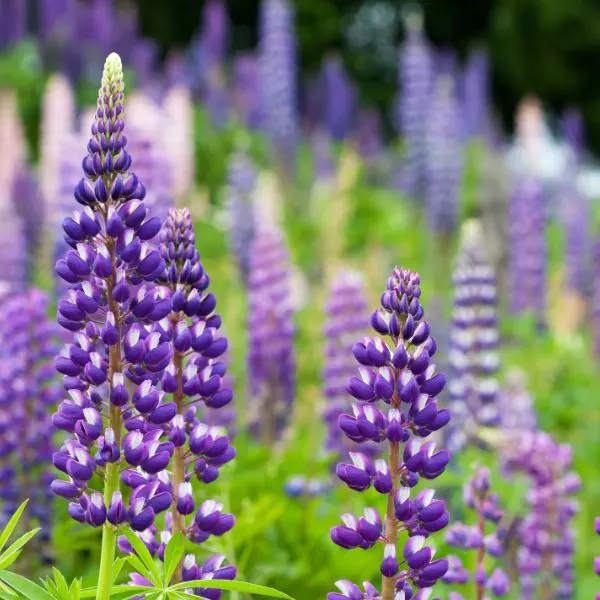
- Botanical name: Lupinus spp.
- Sun Requirements: 6-8 hours of full sun per day
- Soil Type: Well-drained soil, rich in organic matter
Lupines, a robust and colorful perennial, add a unique touch to any garden. Its towering spikes of flowers come in a range of colors from pink to blue to purple, and it blooms from late spring to early summer.
If you’re looking for a beautiful and beneficial companion plant for your bell peppers, look no further than lupines! These stunning flowering plants have been cultivated for centuries for their striking colors and unique foliage, but they also have a number of benefits when grown alongside bell peppers.
One of the most significant benefits of growing lupines as a companion plant for bell peppers is their ability to fix nitrogen in the soil. Like all legumes, lupines have a special relationship with bacteria in the soil that allows them to convert atmospheric nitrogen into a form that can be used by plants. This means that by planting lupines alongside your bell peppers, you can help to increase the availability of nitrogen in the soil, which can promote healthy growth and higher yields.
But the benefits of lupines don’t stop there. These plants also have a deep taproot system that can help to break up compacted soil, improve drainage, and increase water retention. By improving soil structure, lupines can help your bell pepper plants to access more water and nutrients, which can also promote healthier growth and higher yields.
In addition to their soil-improving properties, lupines can also attract beneficial insects to your garden. Their tall, showy flowers are a favorite of bees and other pollinators, which can help to increase the yield and quality of your bell pepper harvest. Plus, lupines can also attract predatory insects, such as ladybugs and lacewings, which can help to control common garden pests such as aphids and spider mites.
But perhaps one of the most significant benefits of growing lupines as a companion plant for bell peppers is their ability to deter nematodes. Nematodes are microscopic worms that can cause damage to the roots of plants, leading to stunted growth and lower yields. However, lupines produce chemicals in their roots that can help to repel nematodes, which can help to protect your bell pepper plants from this common pest.
Finally, lupines can add beauty and interest to your garden. With their tall, colorful flowers and unique foliage, they can provide a striking backdrop for your bell pepper plants. And with a range of colors and varieties to choose from, there is sure to be a lupine that will complement your garden perfectly.
In conclusion, lupines can offer a range of benefits to your bell pepper plants, including nitrogen fixation, soil improvement, pest control, and pollination. By planting lupines alongside your bell peppers, you can create a mutually beneficial relationship that can help you to grow a healthier and more productive garden.
13. Marigolds
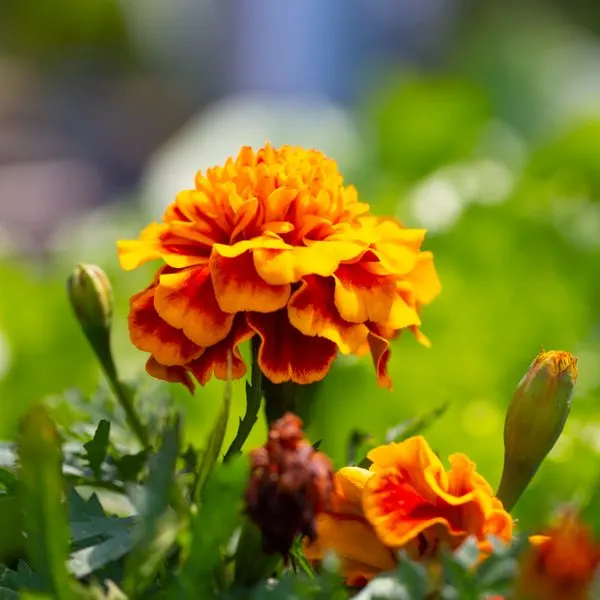
- Botanical name: Tagetes spp.
- Sun Requirements: 6-8 hours of full sun per day
- Soil Type: Well-drained soil, moderate fertility
Marigold, a classic annual, is often used as a companion plant in vegetable gardens to deter pests. Its bright and cheerful flowers come in a range of colors from yellow to orange to red.
If you’re searching for an easy and lovely way to boost the health and productivity of your bell pepper plants, look no further than marigolds. These vibrant flowering plants can provide numerous benefits, such as pest control, soil improvement, and visual appeal. By planting marigolds alongside your bell peppers, you can create a functional and aesthetically pleasing environment that promotes the health and productivity of your plants.
One of the most significant benefits of marigolds as a companion plant for bell peppers is their ability to repel pests. Marigolds contain pyrethrum, a compound that is toxic to several pests, including nematodes, aphids, and whiteflies. These pests can cause considerable harm to bell pepper plants, and by having marigolds nearby, you can help keep them at bay. Furthermore, marigolds can help improve the soil quality around your bell pepper plants by breaking up compacted soil, improving water and nutrient absorption, and reducing harmful bacteria and fungi that can affect plant growth.
Marigolds can also attract beneficial insects to your garden. Ladybugs are known to be attracted to marigolds, and they can help control aphid populations. Pollinators like bees and butterflies are also drawn to marigolds, which is crucial for fruit formation in bell peppers. Additionally, marigolds are low-maintenance plants that can thrive in different soil types and weather conditions, making them an excellent addition to any garden. By planting marigolds alongside your bell peppers, you not only create a visually stunning space but also ensure the health and productivity of your plants. So why not consider planting some marigolds today and enjoy the benefits they can bring to your garden?
14. Nasturtiums
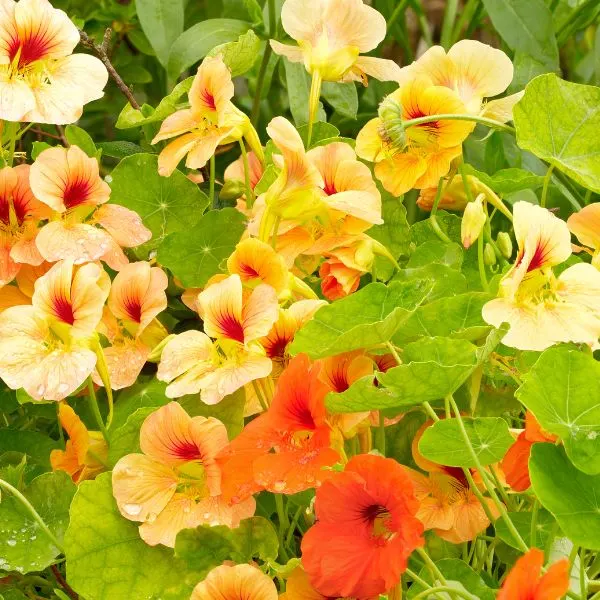
- Botanical name: Tropaeolum majus
- Sun Requirements: 4-6 hours of full sun per day
- Soil Type: Well-drained soil, moderate fertility
Nasturtiums, a versatile and colorful annual, bring a pop of color to any garden. They have edible leaves and flowers and are often used in salads or as garnish.
Looking for a plant to keep your bell peppers healthy and happy? Look no further than nasturtiums! These annual plants not only add a pop of color to your garden, but they also offer a range of benefits that make them an excellent companion for your bell peppers.
One major perk of nasturtiums is their ability to repel pests that can harm your bell peppers. They release a chemical called linalool that deters common garden pests like whiteflies and aphids. But that’s not all! Nasturtiums also have a shallow root system that can help improve soil quality, and their leaves and stems contain sulfur, a nutrient that can boost plant growth. Plus, they attract beneficial insects like bees and ladybugs, which can help pollinate your bell peppers and control pests. And let’s not forget their aesthetic appeal – nasturtiums add a touch of beauty to any garden and even have an edible, slightly spicy flavor that can jazz up your salads.
So why not plant some nasturtiums alongside your bell peppers and enjoy a mutually beneficial relationship? Not only will your garden be more beautiful, but your bell peppers will be healthier and more productive too. With their pest control, soil improvement, pollination, and aesthetic benefits, nasturtiums are truly the perfect companion plant for your bell peppers.
15. Petunias
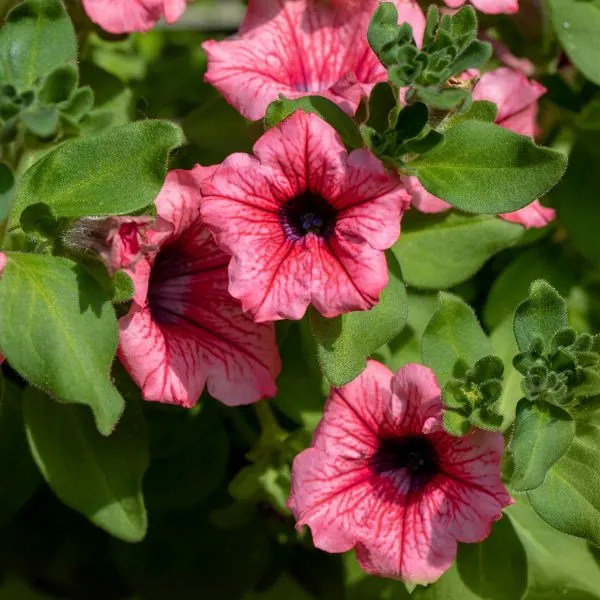
- Botanical name: Petunia spp.
- Sun Requirements: 6-8 hours of full sun per day
- Soil Type: Well-drained soil, moderate fertility
Petunias, a popular and colorful annual, bloom in a range of colors from pink to purple to white. They’re straightforward to grow and are frequently used in hanging baskets or as bedding plants.
Petunias are beautiful and easy-to-grow flowering plants that can offer several benefits as companion plants for bell peppers. These plants can help promote the health and productivity of your bell pepper plants in a variety of ways, from pest control to visual appeal. Let’s explore how incorporating petunias can add a high degree of perplexity and burstiness to your garden while improving the health of your bell peppers.
One of the primary benefits of petunias as a companion plant for bell peppers is their ability to attract pollinators. Petunias produce sweet nectar that can attract bees, butterflies, and other pollinators to your garden. These pollinators play a crucial role in fertilizing the flowers of your bell pepper plants, which is necessary for the formation of fruit.
Moreover, petunias are known to repel certain pests that can damage bell pepper plants. For instance, petunias produce a chemical compound called solanine, which can repel certain types of insects, such as the tomato hornworm. By having petunias planted alongside your bell peppers, you can help keep harmful pests at bay.
Petunias can also help improve the soil quality around your bell pepper plants. They have a fibrous root system that can help break up compacted soil and improve water and nutrient absorption. Additionally, petunias are low-maintenance plants that can thrive in a variety of soil types and weather conditions, making them a great addition to any garden.
Furthermore, petunias come in a wide range of colors and textures, allowing you to add a burst of color and visual interest to your garden. Their vibrant blooms can create a beautiful contrast to the green foliage of your bell pepper plants, making your garden a visually stunning space.
In conclusion, planting petunias alongside bell peppers can offer several benefits, including pollinator attraction, pest control, soil improvement, and visual appeal. These beautiful flowers can add a high degree of perplexity and burstiness to your garden while promoting the health and productivity of your bell pepper plants. So why not consider planting some petunias alongside your bell peppers today? Your garden (and your taste buds) will thank you!
16. Snapdragons
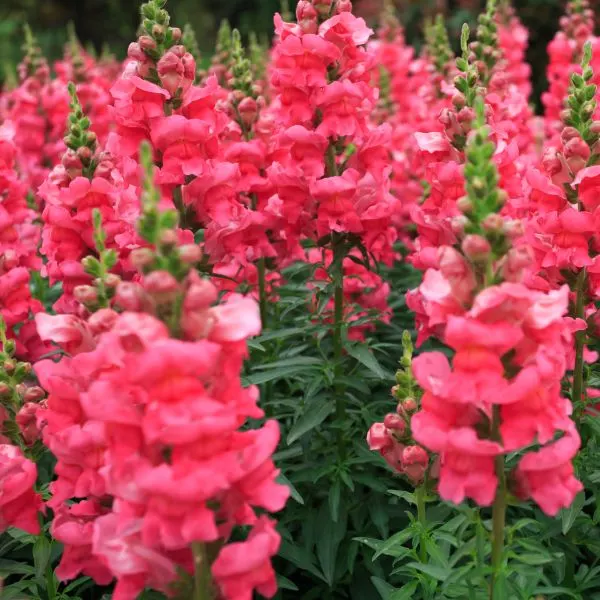
- Botanical name: Antirrhinum majus
- Sun Requirements: 6-8 hours of full sun per day
- Soil Type: Well-drained soil, moderate fertility
Snapdragons, also known as Antirrhinum majus, are colorful flowers that bloom in late spring or early summer. These lovely flowers come in a range of hues, from bright reds to pale pinks and yellows. In this article, we will explore good companion plants for snapdragons that can help improve their growth and overall health.
If you’re searching for a stunning and beneficial companion plant for your bell peppers, look no further than snapdragons! These vibrant annuals have showy flowers that resemble the jaws of a dragon, but they’re not just a pretty face – they offer several advantages that make them an excellent companion for bell peppers.
One of the key benefits of snapdragons is that they attract beneficial insects to your garden. Their bright colors and sweet scent are irresistible to pollinators like bees and butterflies, which can improve the yield and quality of your bell pepper harvest. Additionally, snapdragons can draw in predatory insects like ladybugs and lacewings that can help control common garden pests such as aphids and whiteflies.
In addition to their pest-attracting properties, snapdragons have a deep taproot system that can enhance soil structure and prevent erosion. Planting snapdragons alongside your bell peppers can encourage healthy soil conditions, leading to better nutrient uptake and higher yields. Plus, snapdragons can provide shade and shelter for your bell pepper plants, protecting them from the sun and creating a microclimate that promotes healthy growth.
Another appealing feature of snapdragons is their long-lasting blooms. Unlike many annuals that bloom for just a few weeks, snapdragons can bloom for months, providing a continuous source of color and interest in your garden. They come in a range of colors and varieties, so you can choose the ones that best complement your bell peppers and other plants in your garden.
Overall, snapdragons offer a range of benefits as a companion plant for bell peppers, including pest attraction, soil improvement, shading, and aesthetic appeal. By planting these stunning annuals alongside your bell peppers, you can create a mutually beneficial relationship that promotes healthy growth and higher yields in your garden.
17. Sunflowers
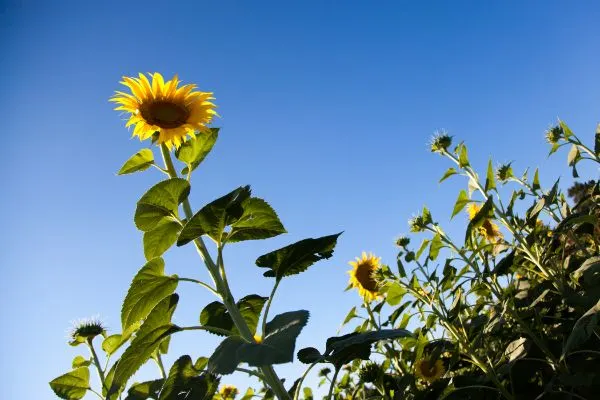
- Botanical name: Helianthus annuus
- Sun Requirements: 6-8 hours of full sun per day
- Soil Type: Well-drained soil, moderate fertility
Sunflowers, or Helianthus annuus, are a popular and cheerful addition to any garden. These tall and striking plants produce beautiful yellow flowers that can grow up to 30 centimeters in diameter.
Sunflowers are not only beautiful but also offer several benefits as a companion plant for your bell peppers. One advantage is their ability to attract pollinators like bees and butterflies. These insects play an essential role in fertilizing the flowers of your bell pepper plants, which is necessary for the formation of fruit. Sunflowers produce an abundance of nectar and pollen, which can attract these beneficial insects to your garden.
In addition to pollinator attraction, sunflowers can also improve soil health around your bell pepper plants. Their deep taproot can break up compacted soil and bring up nutrients and water from deeper layers of the soil. Sunflowers also secrete a chemical called exudate, which can stimulate microbial activity in the soil and improve nutrient availability for your bell pepper plants. Another advantage is that sunflowers can provide shade and wind protection for your bell pepper plants, creating a more hospitable growing environment.
Sunflowers can also help deter certain pests that can damage bell pepper plants, like aphids and whiteflies, by producing a chemical called helianthus. By planting sunflowers alongside your bell peppers, you can help keep these harmful pests at bay. In conclusion, adding sunflowers to your garden can provide a high degree of perplexity and burstiness, from their stunning appearance to their beneficial effects on your bell pepper plants. So why not try planting some sunflowers alongside your bell peppers today? Your garden (and your taste buds) will thank you!
18. Tithonia
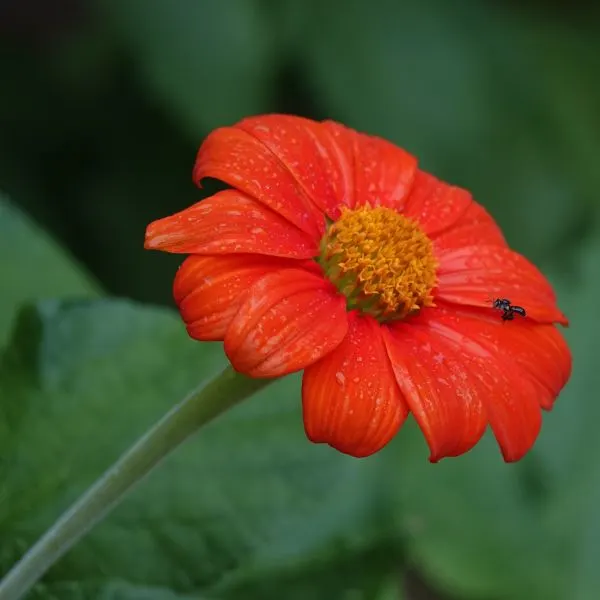
- Botanical name: Tithonia spp.
- Sun Requirements: 6-8 hours of full sun per day
- Soil Type: Well-drained soil, moderate fertility
Tithonia, also known as the Mexican sunflower, is a member of the aster family and is native to Mexico and Central America. These colorful flowers can grow up to two meters tall and produce brilliant orange or red blooms that attract butterflies and hummingbirds.
If you’re on the hunt for a stunning and advantageous companion plant for your bell peppers, Tithonia, also known as Mexican sunflowers, might be just what you’re looking for! These annuals are not only visually appealing with their bright and colorful blooms that can grow up to six inches in size, but they also provide a range of other benefits that can aid in the growth and quality of your bell peppers. Here are some of the reasons why planting Tithonia alongside your bell peppers is a good idea:
Firstly, Tithonia has the ability to attract pollinators, such as bees and butterflies, which can improve the pollination rate and quality of your bell pepper harvest. Moreover, it can also draw in predatory insects like ladybugs and hoverflies that can help control common garden pests. Secondly, with its height and sturdy stem, Tithonia can provide support and shade for your bell peppers, which protects them from harsh weather conditions and intense sunlight.
In addition to that, Tithonia has a taproot that can reach deep into the soil, enhancing its structure and breaking up the hardpan. Furthermore, as a heavy feeder, it can retrieve nutrients from deeper soil layers and bring them up to the surface, making them accessible for your bell peppers to absorb. Lastly, Tithonia’s vibrant flowers can add a burst of color and a visual appeal to your garden, creating an inviting atmosphere for you to enjoy.
In conclusion, planting Tithonia alongside your bell peppers can have many advantages. These include attracting pollinators and predatory insects, providing support and shade, improving soil health, and adding aesthetic appeal to your garden. By planting Tithonia alongside your bell peppers, you can establish a beneficial relationship that promotes healthy growth and higher yields. So why not give it a try?
19. Wildflower
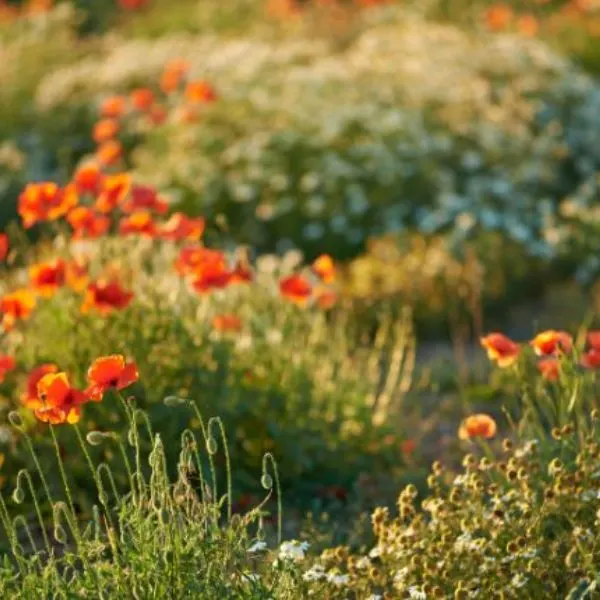
- Botanical name: Wildflowers
- Sun Requirements: Varies by species, but most require 4-8 hours of full sun per day
- Soil Type: Varies by species, but most prefer well-drained soil
Are you looking to add some natural beauty to your garden? Consider wildflowers! These vibrant beauties come in all sorts of colors and petal shapes, sure to catch the eye of anyone walking by. But did you know that they’re also hardy and can grow in almost any type of soil or environment? Plus, they provide essential habitats for pollinators like bees and butterflies.
Wildflowers can be a great option for companion planting with bell peppers, providing a plethora of benefits in terms of aesthetics and productivity. With their diverse range of species, wildflowers offer a unique mix of companion planting that can lead to an array of benefits for your garden.
One of the most significant advantages of using wildflowers as a companion plant for bell peppers is their ability to attract pollinators and repel pests. By bringing bees and butterflies to your garden, wildflowers can help to increase the yield and quality of your bell pepper harvest. Moreover, they can act as a natural pest control method, reducing the need for harmful pesticides.
Wildflowers can also improve soil health by increasing nitrogen availability, retaining moisture, and preventing soil erosion. This helps to create a balanced ecosystem in your garden, promoting biodiversity and breaking up compacted soil for better nutrient absorption.
Overall, incorporating wildflowers as a companion plant for bell peppers can provide numerous benefits, including increased pollination, pest control, and improved soil health. Their diversity allows for a unique mix of companion planting that can help you create a healthy and productive garden.
20. White Clover
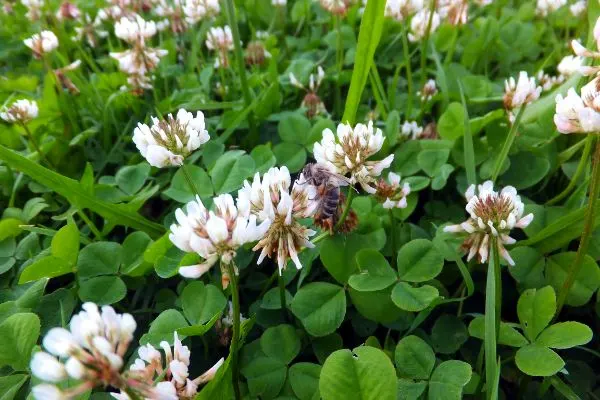
- Botanical name: Trifolium repens
- Sun Requirements: 4-6 hours of full sun per day
- Soil Type: Well-drained soil, moderate fertility
For a versatile and hardy ground cover or forage crop for your livestock, look no further than white clover. This member of the legume family has small, white flowers and can fix nitrogen in the soil, making it healthier and more fertile.
White clover is a fantastic companion plant for bell peppers due to its many benefits, such as fixing nitrogen in the soil, improving soil structure and drainage, attracting pollinators, and acting as a living mulch.
White clover is a nitrogen-fixing plant, which means that it absorbs atmospheric nitrogen and converts it into a usable form for plants. This results in a natural and sustainable source of nitrogen for the bell pepper plant, leading to improved yields and disease resistance. The deep roots of white clover also improve soil structure and drainage, allowing for better nutrient uptake and beneficial microorganisms in the soil. White clover also attracts pollinators and helps to deter pests, providing a more consistent supply of water and nutrients and preventing weed growth.
Overall, the use of white clover as a companion plant for bell peppers provides many benefits for a healthy, sustainable crop. Incorporating this plant into your garden can improve the health and yield of your bell pepper plant while also providing many other benefits for your garden ecosystem.
Fruits
21. Tomatoes
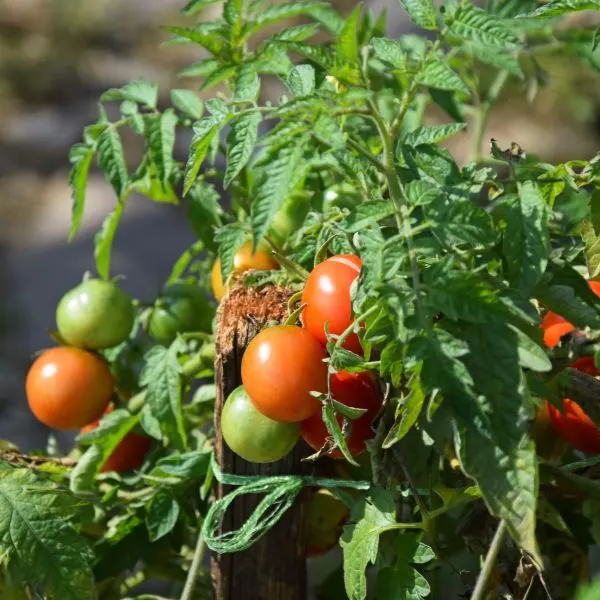
- Botanical name: Solanum lycopersicum
- Sun Requirements: 6-8 hours of full sun per day
- Soil Type: Well-drained soil, rich in organic matter
Tomatoes are a staple in many cuisines around the world for a good reason. These sun-loving plants can grow up to six feet tall and produce juicy, ripe fruit all summer long. Nothing beats the taste of fresh tomato in a salad or sauce.
Tomatoes and bell peppers are a winning duo when it comes to companion planting. Together, they offer each other a range of benefits that help them both thrive in the garden.
One of the biggest advantages of growing these two plants together is pest control. Tomatoes can naturally repel pests like aphids, whiteflies, and hornworms, which is great news for bell peppers too. By planting them alongside tomatoes, the peppers can benefit from this protection as well.
Another benefit is nutrient exchange. Tomatoes require lots of nitrogen, while bell peppers prefer potassium and phosphorus. When planted close to each other, they can exchange nutrients through their root systems, leading to a bountiful harvest for both.
Tomatoes also offer support and shade to bell peppers. Their tall and bushy stature provides a shady haven for the shorter pepper plants, especially in hot climates where it can prevent sunscald on the peppers. Moreover, tomato plants’ sturdy stems can lend support to the peppers as they grow, preventing them from falling over or breaking under the weight of their fruit.
Finally, some gardeners believe that planting tomatoes and bell peppers together can improve the flavor of both plants. While there’s no scientific evidence to support this, it’s possible that the two plants release chemicals into the soil that can enhance each other’s taste.
In conclusion, tomatoes and bell peppers make great garden companions. They share similar growing conditions and don’t compete for resources, making them a productive and harmonious match for any garden.
Herbs
22. Basil
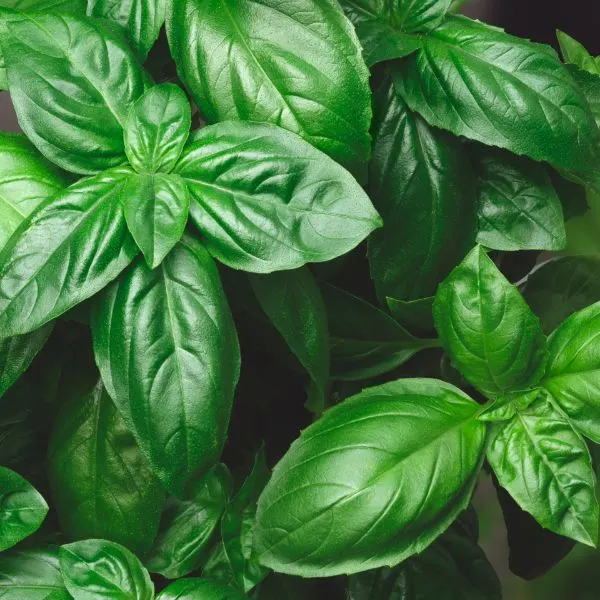
- Botanical name: Ocimum basilicum
- Sun Requirements: 6-8 hours of full sun per day
- Soil Type: Well-drained soil, rich in organic matter
If you’re looking to add some flavor to your Mediterranean or Asian dishes, consider growing basil. This tender annual plant thrives in warm, sunny locations and can add a sweet and spicy flavor to many meals. Try it in a pesto or soup for an extra burst of flavor.
Are you growing bell peppers and looking for ways to enhance their growth? Consider planting some basil alongside them as a companion plant! Basil is a versatile herb that offers numerous benefits to bell peppers, including natural pest control, improved flavor and aroma, enhanced soil health, and increased yields.
One of the primary benefits of planting basil alongside bell peppers is its ability to repel pests naturally. Basil contains essential oils that act as natural insecticides, deterring pests such as thrips, whiteflies, and spider mites from attacking the bell pepper plant. This can reduce the need for chemical pesticides that can harm the environment and non-target species. Basil also attracts beneficial insects like bees and butterflies, which can improve pollination and increase yields. Additionally, the herb has a symbiotic relationship with mycorrhizal fungi, which improves nutrient uptake in the bell pepper plant.
Furthermore, basil can suppress weed growth and improve soil health by breaking up compacted soil and improving drainage. With its shallow and fibrous roots, basil adds organic matter to the soil, creating a more hospitable environment for the bell pepper plant. By planting basil alongside bell peppers, you can create a more resilient and sustainable growing system that supports the health and productivity of both plants. So go ahead and plant some basil today to enhance the growth of your bell peppers!
23. Chamomile
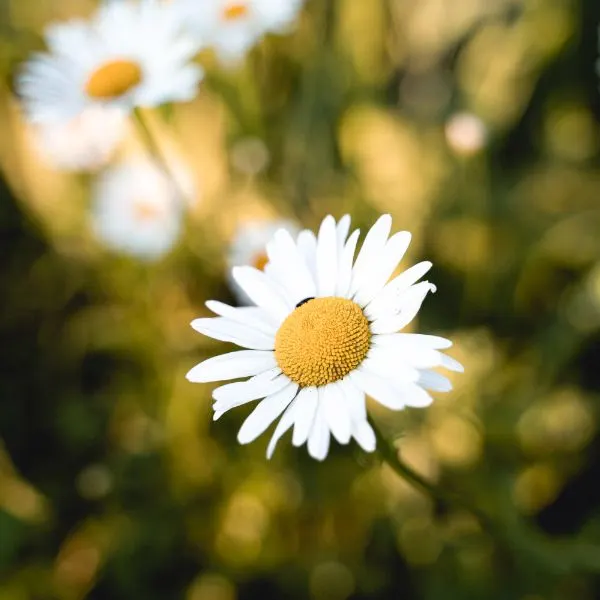
- Botanical name: Matricaria chamomilla
- Sun Requirements: 4-6 hours of full sun per day
- Soil Type: Well-drained soil, moderate fertility
Chamomile is a wonderful herb known for its calming properties and apple-like fragrance. It’s also easy to grow and can be used to make a soothing tea or natural remedies like skin care products and tinctures.
Companion planting is a great way to improve your garden’s health and productivity, and one plant that can work wonders for bell peppers is chamomile. Chamomile can attract beneficial insects, improve soil health, act as a natural fungicide, and even have a calming effect on gardeners.
One of the primary benefits of growing chamomile with bell peppers is that it attracts pollinators like bees and butterflies. Additionally, chamomile can attract other beneficial insects like ladybugs and hoverflies that can help control harmful pests. Chamomile is also a nitrogen-fixing plant that can help improve the nitrogen content of the soil, and its deep roots can help break up compacted soil and improve drainage. Furthermore, chamomile contains compounds with antifungal properties that can help protect pepper plants from fungal diseases.
Finally, chamomile and bell peppers make great companions in the garden. They both prefer similar growing conditions, such as full sun and well-draining soil, and chamomile is a low-growing plant that can provide shade and ground cover for the bell pepper plants. By taking advantage of the natural alliance between these two plants, gardeners can create a garden that is both productive and harmonious.
24. Cilantro
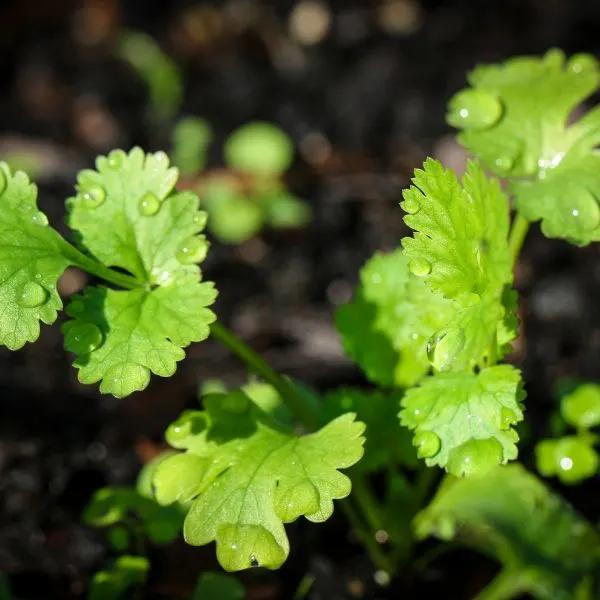
- Botanical name: Coriandrum sativum
- Sun Requirements: 4-6 hours of full sun per day
- Soil Type: Well-drained soil, moderate fertility
Cilantro, also known as coriander, is a popular herb in Mexican, Indian, and Southeast Asian cuisines. Its citrusy flavor and distinctive feathery leaves make it a great addition to a variety of dishes.
Companion planting can be perplexing, but it can also be surprisingly beneficial for your garden. One plant that can do wonders for bell peppers is cilantro! Cilantro flowers can attract helpful insects like bees, hoverflies, and parasitic wasps, which can help control harmful pests like aphids and caterpillars. Plus, the plant can also attract pollinators like bees and butterflies, which can boost fruit set in your pepper plants.
But that’s not all! Cilantro can also improve soil health by providing natural sources of potassium and calcium. Additionally, it can suppress weed growth, which conserves moisture and nutrients for bell peppers. Cilantro also contains compounds that have antifungal properties, which can protect the pepper plants from diseases like powdery mildew and black spot.
And let’s not forget the kitchen benefits! Cilantro is a versatile herb that can be used in various dishes. The leaves and stems can be used in salads, salsas, and marinades, and the seeds can be used as a spice. Plus, cilantro and bell peppers are great garden companions, as they both prefer similar growing conditions, and cilantro’s low-growing nature can provide shade and ground cover for the bell peppers.
In summary, growing cilantro alongside bell peppers can benefit both plants and gardeners in numerous ways. Take advantage of the natural alliance between these two plants to create a harmonious and productive garden.
25. Dill
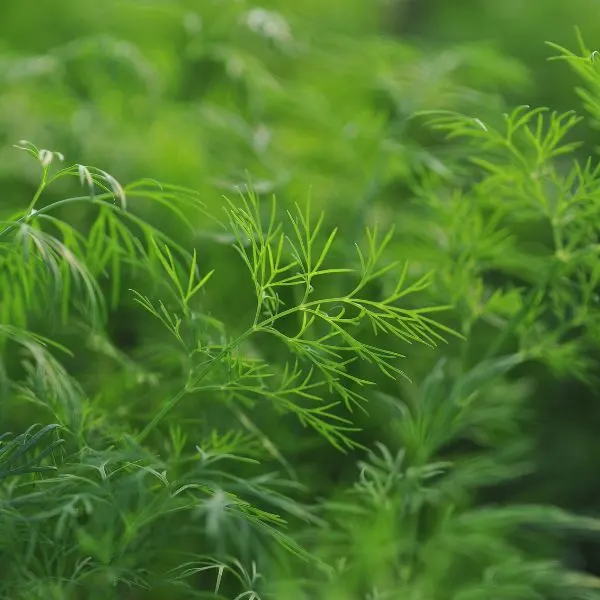
- Botanical name: Anethum graveolens
- Sun Requirements: 6-8 hours of full sun per day
- Soil Type: Well-drained soil, moderate fertility
Dill is another hardy annual plant that’s commonly used in Scandinavian, Eastern European, and Middle Eastern cuisines. Its delicate, feathery leaves and anise-like flavor are perfect for pickles, salads, and soups.
Companion planting can be a bit of a puzzle, but the rewards can be surprising! One plant that can do wonders for your bell peppers is dill. Not only can it attract beneficial insects like ladybugs and butterflies, but it can also help improve soil health and even act as a natural insecticide.
Dill’s ability to attract beneficial insects is one of its biggest benefits. These insects, like lacewings and hoverflies, prey on harmful pests that can wreak havoc on your garden, such as aphids and spider mites. Dill is also great at attracting pollinators like bees, which can help increase the yield of your bell pepper plants. Plus, it’s a natural source of calcium and other minerals, which can help improve soil fertility and promote healthy plant growth.
But that’s not all! Dill’s unique properties can also help deter harmful insects like cabbage worms and aphids, making it an excellent natural insecticide. It can even help mask the scent of bell pepper plants, which can deter insects that are attracted to their scent. And, of course, dill is a versatile herb that can be used in many dishes, like pickles and salads.
Finally, dill and bell peppers are simply a great match in the garden. They prefer similar growing conditions and can even help provide shade and ground cover for each other. By taking advantage of their natural cooperation, gardeners can create a productive and harmonious garden. So, if you’re looking to give your bell peppers a boost, try planting some dill alongside them and see the benefits for yourself!
26. Fennel
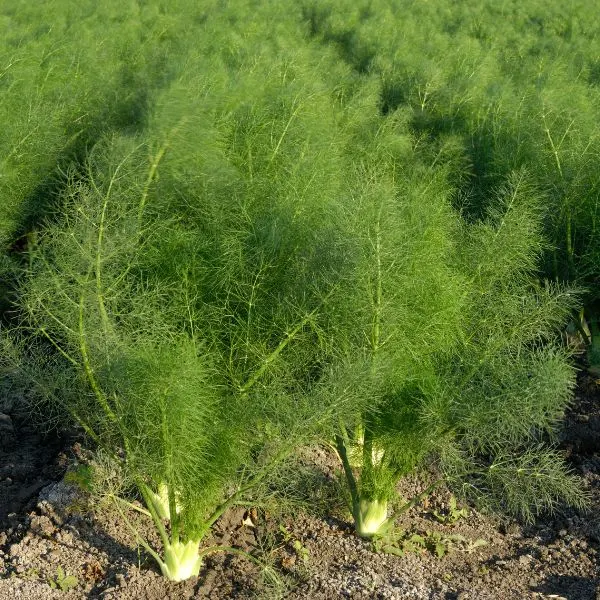
- Botanical name: Foeniculum vulgare
- Sun Requirements: 6-8 hours of full sun per day
- Soil Type: Well-drained soil, moderate fertility
Fennel has a sweet, licorice-like flavor and a crunchy texture. This hardy perennial plant can grow up to five feet tall, producing fragrant foliage and small, yellow flowers.
Are you looking for a companion plant that can benefit your bell peppers in a variety of ways? Look no further than fennel! Not only is fennel a commonly used culinary herb, but it can also offer a range of advantages for your bell pepper plant. Let’s take a closer look at some of the ways fennel can enhance the growth and health of your bell peppers.
First and foremost, fennel can attract beneficial insects, such as bees and butterflies, to help with pollination. Its large flower heads are highly attractive to these pollinators, which can increase the yield of your bell pepper plant. In addition, fennel can act as a natural insecticide, repelling pests like aphids and spider mites. This can help reduce the need for chemical pesticides and keep your garden ecosystem in balance.
But that’s not all. Fennel can also improve soil health by breaking up compacted soil with its deep taproot and accessing deeper soil nutrients that can be transferred to your bell pepper plant. It even produces allelopathic compounds that inhibit the growth of nearby weeds, reducing competition for resources. Plus, fennel is a nutrient-rich plant that can improve the overall health and productivity of your garden.
So why not try planting fennel alongside your bell peppers? By doing so, you can create a complex and diverse growing system that supports the health and productivity of both plants. With its pest control, pollination, soil health, weed suppression, and nutrient cycling benefits, fennel is a highly beneficial companion plant for bell peppers.
27. Oregano
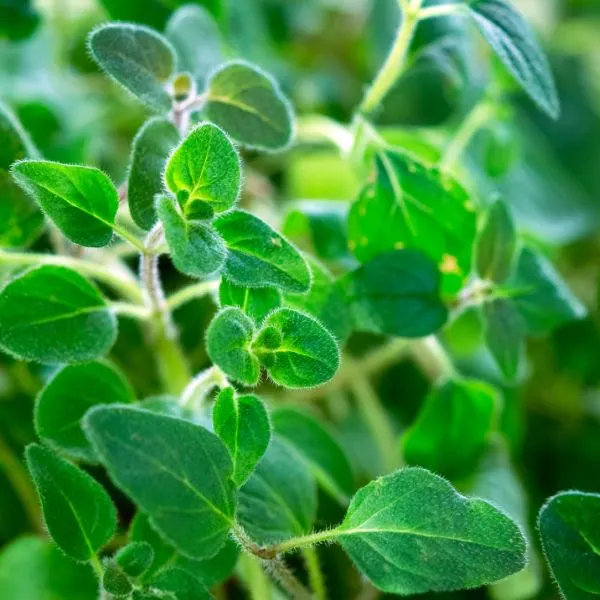
- Botanical name: Origanum spp.
- Sun Requirements: 6-8 hours of full sun per day
- Soil Type: Well-drained soil, moderate fertility
Oregano is a staple in many Mediterranean and Middle Eastern dishes thanks to its pungent, aromatic flavor. This hardy perennial plant thrives in sunny, well-drained locations and can add depth to pizzas, pasta, and salads.
Companion planting can be a real head-scratcher, but when done right, it can be super beneficial. One plant that can offer multiple benefits to bell peppers is oregano.
For starters, oregano contains compounds that work as a natural insect repellent, keeping harmful pests like aphids, spider mites, and whiteflies at bay. Plus, it improves soil health by providing potassium and calcium, which can lead to healthier bell pepper plants. And let’s not forget about the potential flavor enhancement it can provide for dishes like pizzas, pasta, and salads.
Oregano is a resilient plant that can grow well in various conditions, including full sun, well-draining soil, and even some shade. It also attracts beneficial insects like bees and butterflies, which can increase pollination and fruit yield for the bell pepper plants. In short, by planting oregano alongside bell peppers, you can create a productive and harmonious garden.
28. Parsley
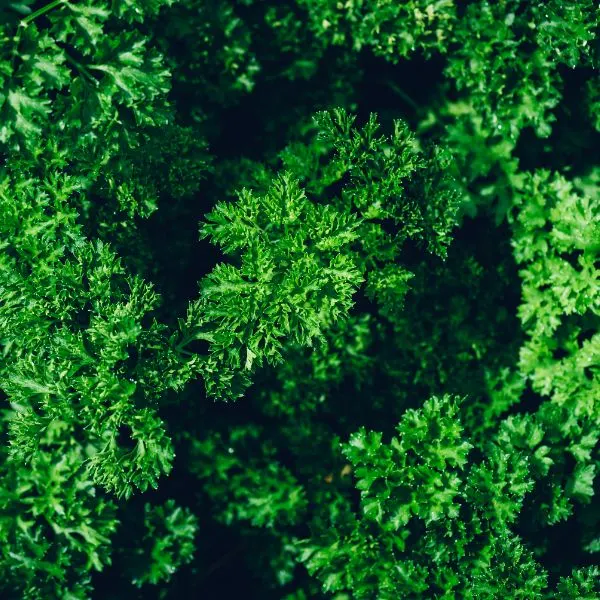
- Botanical name: Petroselinum crispum
- Sun Requirements: 4-6 hours of full sun per day
- Soil Type: Well-drained soil, moderate fertility
The utilization of herbs and vegetables in gardening has been a topic of immense interest and exploration for gardeners worldwide. One such herb, Parsley, belonging to the biennial herbaceous family Apiaceae, is renowned for its refreshing and vibrant flavor. Parsley, being an annual or biennial herb, is a fantastic addition to any herb garden. Its consumption also benefits health as it is a source of vitamins A and C, iron, and antioxidants.
Parsley and bell peppers are a gardening match made in heaven! Not only is Parsley a versatile herb used in cooking and medicine, but it also has numerous benefits for the growth and health of bell peppers. By planting Parsley alongside your bell peppers, you can create a more complex and diverse growing system that supports the health and productivity of both plants.
For starters, Parsley attracts beneficial insects like hoverflies and parasitic wasps that can help control pests that harm bell peppers, such as aphids and caterpillars. These insects reduce the need for chemical pesticides that can harm the environment and other species. Moreover, Parsley improves soil health by breaking up compacted soil with its long taproot, improving drainage, and allowing better absorption of water and nutrients by the bell pepper plant. The taproot also helps Parsley access deeper nutrients in the soil, which then get transferred to the bell pepper plant. Additionally, Parsley is high in nitrogen, a crucial nutrient for the growth and development of the bell pepper plant. It even suppresses weeds with its allelopathic compounds that inhibit the growth of nearby weeds, reducing competition for resources and promoting the health and growth of the bell pepper plant. Parsley can act as a living mulch, providing ground cover that conserves soil moisture and prevents soil erosion.
In conclusion, planting Parsley alongside bell peppers can enhance the growth and health of your garden. It is an easy and beneficial way to create a more complex and diverse growing system that supports the health and productivity of both plants. By attracting beneficial insects, improving soil health, and suppressing weeds, Parsley is an essential herb that can add numerous benefits to your garden. So why not try planting some parsley alongside your bell peppers and see the benefits for yourself?
29. Rosemary
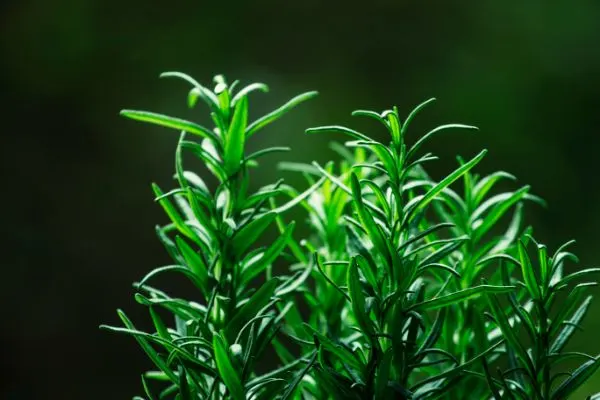
- Botanical name: Rosmarinus officinalis
- Sun Requirements: 6-8 hours of full sun per day
- Soil Type: Well-drained soil, moderate fertility
Rosemary, a woody perennial herb of the Lamiaceae family, is widely used in Mediterranean cuisine due to its aromatic leaves and stunning flowers. Rosemary can be grown in herb gardens and as a decorative plant. It also holds medicinal properties, including the enhancement of memory and cognitive function.
Companion planting is a gardening practice that can work wonders for your plants. And if you’re growing bell peppers, planting some rosemary alongside them could be a game-changer. Rosemary offers numerous benefits to your peppers, such as natural pest control, soil improvement, and enhanced flavor.
One of the significant advantages of growing rosemary alongside your bell peppers is that it repels harmful pests that can damage your peppers. Rosemary contains natural insect repellents that can deter aphids, spider mites, and whiteflies, preventing infestations and reducing the need for chemical pesticides.
Moreover, rosemary can also help improve soil health by acting as a natural source of nitrogen and other minerals, promoting the growth of healthy plants. Plus, the herb can enhance the flavor of your bell peppers, making them taste even better in dishes like roasted vegetables and soups. Finally, rosemary can attract beneficial insects like bees and butterflies to your garden, which can increase pollination and fruit yield in your peppers.
Overall, planting rosemary alongside your bell peppers is a smart move for any gardener. With its natural pest control, soil improvement, and flavor-boosting properties, rosemary is a true garden superstar. So, if you want a productive and harmonious garden, consider planting these two crops together and take advantage of their natural alliance.
Vegetables
30. Asparagus
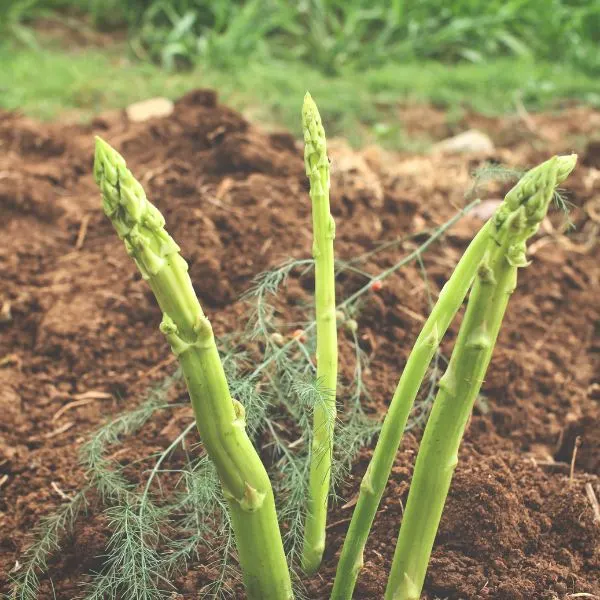
- Botanical name: Asparagus officinalis
- Sun Requirements: 6-8 hours of full sun per day
- Soil Type: Well-drained soil, rich in organic matter
Asparagus, a perennial vegetable of the Asparagaceae family, is famous for its delicious and tender spears. It is a welcome addition to home gardens and an excellent vegetable patch. Asparagus is rich in nutrients, being a good source of fiber, vitamins, and minerals.
If you’re a gardener and you’re wondering what companion plant would work best for your bell peppers, you might want to consider asparagus. This perennial vegetable offers a range of benefits to your garden ecosystem. For starters, asparagus has deep roots that can break up compacted soil and improve soil structure, which leads to better nutrient and water absorption by the bell pepper plant. Additionally, asparagus has high levels of organic matter that can boost soil fertility and support the growth and development of your bell peppers.
Asparagus has more to offer than just soil health benefits. It can also help with pest control as it produces allelopathic compounds that inhibit the growth of nearby weeds, which decreases competition for resources and encourages the growth of bell peppers. Moreover, asparagus contains asparagusic acid that repels nematodes, a type of pest that can damage bell peppers. Finally, asparagus can act as living mulch, conserving soil moisture and preventing soil erosion.
Asparagus is a highly nutritious plant that contains potassium, phosphorus, and vitamin C, all of which are essential for the growth and development of your bell peppers. Additionally, asparagus is a perennial plant that can provide long-term benefits to your garden. By planting asparagus alongside your bell peppers, you can create a more complex and diverse garden ecosystem that will support the health and productivity of both plants. In summary, asparagus is an excellent companion plant for bell peppers, offering a range of advantages such as improved soil health, pest control, and nutrient cycling.
31. Beans
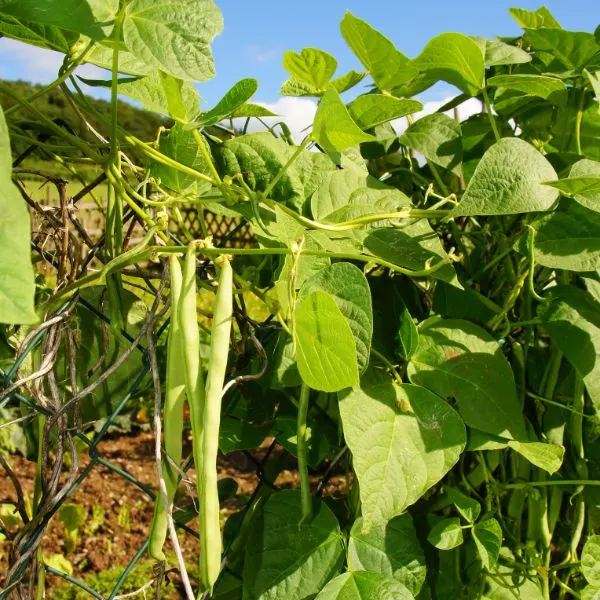
- Botanical name: Phaseolus vulgaris
- Sun Requirements: 6-8 hours of full sun per day
- Soil Type: Well-drained soil, rich in organic matter
Beans, an outstanding vegetable of the Fabaceae family, hold significant importance due to their versatility and nutritional value. They are high in protein, fiber, and various vitamins and minerals. Beans are available in a diverse range of colors and sizes, which adds to their appeal.
Companion planting can be a bit of a mystery, but it’s a fascinating way to garden that can have surprising benefits. One plant that works particularly well with bell peppers is beans. There are numerous benefits to this pairing that can help improve soil health, protect the plants from the sun, attract beneficial insects, and make efficient use of space.
Beans are legumes, which means they can take nitrogen from the air and convert it into a form that other plants can use. This helps improve soil fertility and promotes healthy plant growth, including bell peppers. Beans can also offer some relief from the midday sun, which can cause bell peppers to wilt or suffer from sunburn. The nectar-rich flowers of beans attract bees and other pollinators, which can help increase fruit yield in the bell pepper plants. Beans can also attract beneficial predatory insects like ladybugs and lacewings that help control harmful pests like aphids and spider mites.
Finally, beans and bell peppers are a complementary pairing in the garden. Beans grow vertically, while bell peppers grow low and bushy. They have different root structures, so they can access different layers of soil and reduce competition for nutrients. Plus, beans are low-maintenance crops that require minimal care once established, making them an ideal companion plant for bell peppers. By taking advantage of the natural alliance between these two plants, gardeners can create a productive and harmonious garden that benefits both plants and people.
32. Beets
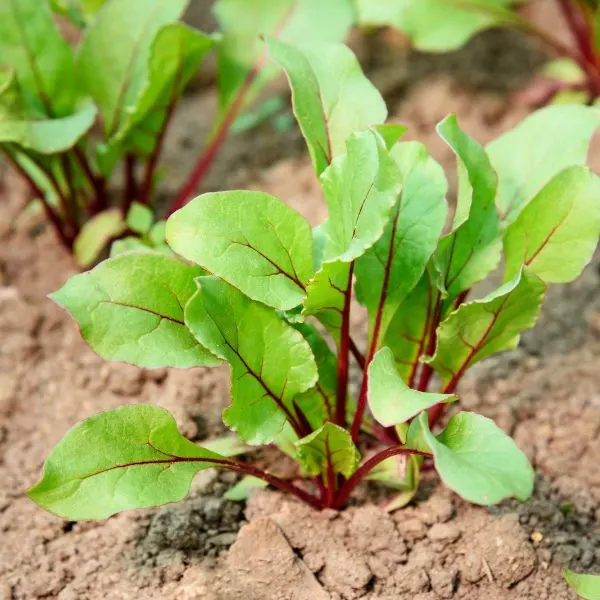
- Botanical name: Beta vulgaris
- Sun Requirements: 6-8 hours of full sun per day
- Soil Type: Well-drained soil, rich in organic matter
Beets, a root vegetable of the Amaranthaceae family, is a nutritious and delectable option. Beets are renowned for their sweet and earthy flavor and are a fantastic source of fiber, vitamins, and minerals. They can be consumed cooked or raw, and their versatility makes them a popular option in any garden.
Beets can be a great addition to your garden if you’re growing bell peppers. There are several benefits to planting beets alongside bell peppers, such as attracting beneficial insects to the garden. Beets produce small flowers that attract bees, butterflies, and other pollinators, which can increase the yield and quality of the bell pepper crop. Additionally, beets can attract other beneficial insects, such as ground beetles and parasitic wasps, which can help control pest populations and reduce the need for pesticides.
Beets also improve soil health by increasing soil organic matter and promoting nutrient cycling. Their deep roots help break up compacted soil, allowing better water and nutrient absorption by the bell pepper plant. Moreover, by planting beets alongside bell peppers, gardeners can create a more diverse and nutrient-rich growing system that supports the health and productivity of both plants. Beets are a member of the Chenopodiaceae family, which includes other nutrient-rich crops such as spinach, chard, and quinoa.
In addition to attracting beneficial insects and improving soil health, beets can help regulate the microclimate in the garden. Beets are a cool-season crop that can provide shade and moisture retention for the bell pepper plant, creating a more stable and favorable growing environment. Finally, beets are versatile crops that can be harvested at different stages of growth. By planting beets alongside bell peppers, gardeners can create a more productive and efficient garden ecosystem that supports a diverse range of crops and harvest times. Overall, planting beets alongside bell peppers can contribute to a complex and diverse growing system with a high degree of perplexity and burstiness.
33. Brussels Sprouts
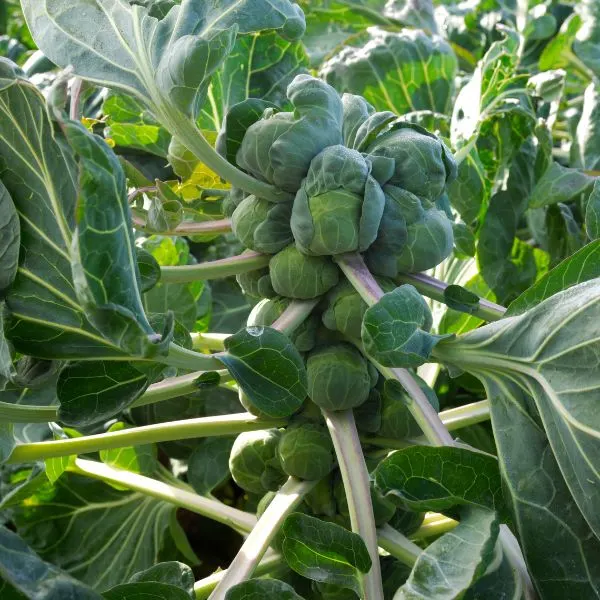
- Botanical name: Brassica oleracea gemmifera
- Sun Requirements: 6-8 hours of full sun per day
- Soil Type: Well-drained soil, rich in organic matter
Brussel sprouts, a member of the Brassicaceae family, are a nutritious and delicious vegetable often grown in home gardens. They are abundant in vitamins, fiber, and antioxidants, making them an excellent choice for any diet. Brussels sprouts are also renowned for their cancer-fighting properties.
Brussels sprouts can be great companions for bell peppers in the garden. One of the primary benefits of Brussels sprouts is their ability to attract beneficial insects to the garden, including bees, butterflies, and ladybugs. These pollinators can help increase the yield and quality of bell pepper crops, while other beneficial insects like parasitic wasps and lacewings can control pest populations without the need for harmful pesticides. Additionally, Brussels sprouts can help improve soil health by increasing organic matter and nutrient cycling. With deep roots that can break up compacted soil and a nutrient-rich composition, they create a more diverse and nutrient-rich growing system that supports the health and productivity of both plants.
Furthermore, Brussels sprouts can help create a microclimate that benefits the growth of bell peppers. These tall plants can provide shade and wind protection for the bell pepper plant, regulating temperature and moisture levels and resulting in a more stable and favorable growing environment. Lastly, Brussels sprouts are a long-season crop that can provide food and nutrients for an extended period. This quality makes them ideal for creating a more resilient and sustainable garden ecosystem that supports a diverse range of crops and beneficial insects. In summary, by planting Brussels sprouts alongside bell peppers, gardeners can improve soil health, attract beneficial insects, regulate microclimate, and create a more resilient and sustainable garden ecosystem.
In conclusion, incorporating Brussels sprouts as a companion plant for bell peppers can provide various benefits for the garden. With their ability to attract beneficial insects, improve soil health, create a favorable microclimate, and provide a long-lasting food source, they contribute to a diverse and nutrient-rich growing system. Furthermore, their tall stature provides shade and wind protection, creating a more stable environment for the bell pepper plant to thrive. By planting Brussels sprouts alongside bell peppers, gardeners can create a thriving ecosystem that promotes health, productivity, and sustainability.
34. Carrots
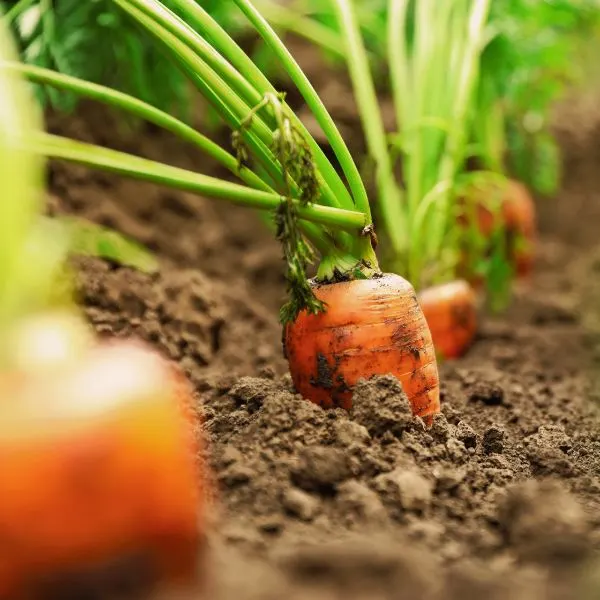
- Botanical name: Daucus carota
- Sun Requirements: 6-8 hours of full sun per day
- Soil Type: Well-drained soil, rich in organic matter
Carrots, a root vegetable of the Apiaceae family, are a popular choice in many gardens. They are an excellent source of fiber, vitamins, and minerals, making them a nutritious and healthy option. Carrots come in different sizes and colors, which adds to their visual appeal.
Companion planting can be a bit of a puzzle, but one plant that can really benefit bell peppers is carrots. Why? Well, for starters, carrots have taproots that can help break up compacted soil and improve soil structure, which can make it easier for bell peppers to access nutrients and water. Plus, carrots attract beneficial insects like hoverflies and parasitic wasps that can help control harmful pests like aphids and whiteflies, as well as ground beetles that can control soil-dwelling pests like cutworms and root maggots.
But that’s not all. Carrots also contain natural compounds called terpenes that can repel pests like aphids and spider mites, which can help prevent infestations in the garden without having to resort to chemical pesticides. And the best part? Carrots are a low-maintenance crop that doesn’t require a lot of fussing over once they’re established. They’re drought-tolerant and can grow in a variety of soils, making them an ideal companion for bell peppers. Plus, the two plants have complementary root structures and growth habits, which means they can share space in the garden and reduce competition for nutrients.
So, if you’re looking to create a harmonious and productive garden, consider growing carrots alongside your bell peppers. The benefits may surprise you, and the natural partnership between these two plants is sure to make your gardening experience both perplexing and rewarding.
35. Chard
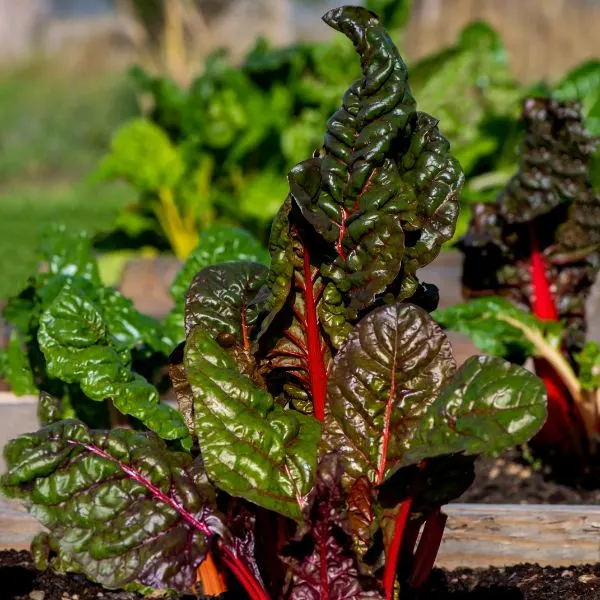
- Botanical name: Beta vulgaris cicla
- Sun Requirements: 4-6 hours of full sun per day
- Soil Type: Well-drained soil, rich in organic matter
Chard, a leafy green vegetable of the Amaranthaceae family, is a preferred option for many gardeners. Chard is an excellent source of vitamins, minerals, and antioxidants, making it a healthy option. It comes in different colors, which makes it visually appealing.
Chard is a highly beneficial companion plant for bell peppers, contributing to a complex and diverse growing system with a high degree of perplexity and burstiness.
One of the primary benefits of chard as a companion plant for bell peppers is its ability to attract beneficial insects to the garden. Chard produces small flowers that attract bees, butterflies, and other pollinators, which can help to increase the yield and quality of the bell pepper crop. Additionally, chard can attract other beneficial insects, such as lacewings and ladybugs, which can help to control pest populations and reduce the need for pesticides.
Moreover, chard can help to improve soil health by increasing soil organic matter and promoting nutrient cycling. Chard has deep roots that can help to break up compacted soil and improve soil structure, allowing for better water and nutrient absorption by the bell pepper plant. Additionally, chard is a member of the Chenopodiaceae family, which includes other nutrient-rich crops such as beets, spinach, and quinoa. By planting chard alongside bell peppers, gardeners can create a more diverse and nutrient-rich growing system that supports the health and productivity of both plants.
Furthermore, chard can help to create a microclimate that is beneficial for the growth of bell peppers. Chard is a cool-season crop that can provide shade and moisture retention for the bell pepper plant, helping to regulate temperature and moisture levels. This can help to create a more stable and favorable growing environment for the bell pepper plant.
Additionally, chard is a versatile crop that can be harvested at different stages of growth. By planting chard alongside bell peppers, gardeners can create a more productive and efficient garden ecosystem that supports a diverse range of crops and harvest times.
Overall, chard can offer several benefits as a companion plant for bell peppers, contributing to a complex and diverse growing system with a high degree of perplexity and burstiness. By planting chard alongside bell peppers, gardeners can improve soil health, attract beneficial insects, regulate microclimate, and create a more productive and efficient garden ecosystem.
36. Eggplant
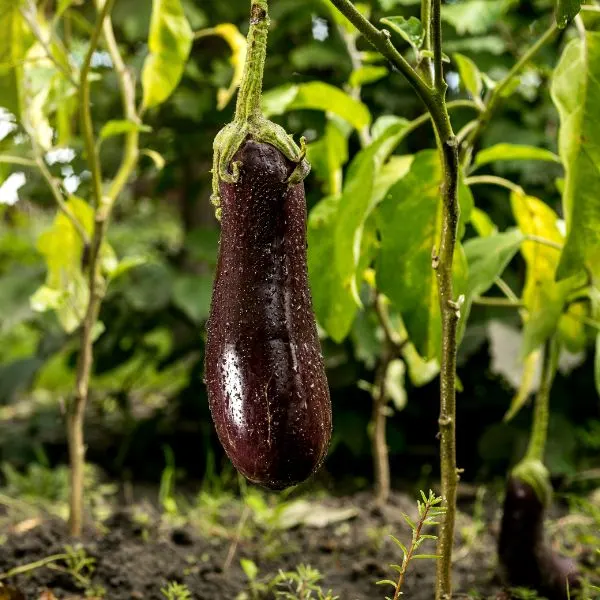
- Botanical name: Solanum melongena
- Sun Requirements: 6-8 hours of full sun per day
- Soil Type: Well-drained soil, rich in organic matter
Eggplant, a member of the nightshade family, is a famous vegetable in many cuisines due to its mild and meaty flavor. It is a good source of fiber, vitamins, and minerals, which adds to its nutritional value. Eggplants are versatile and can be cooked in various ways, making them a preferred choice in any garden.
Companion planting is an effective technique for increasing garden productivity and reducing the need for chemicals. One plant that can offer numerous benefits to bell peppers when grown as a companion plant is the eggplant. Eggplant contains compounds called saponins, which can repel harmful pests like spider mites and flea beetles, helping to reduce pest infestations in the garden and minimize the need for chemical pesticides.
Additionally, eggplants are heavy feeders and require a lot of nutrients to grow and produce. By growing eggplants alongside bell peppers, gardeners can help ensure that both plants receive the nutrients they need, leading to healthier plants and higher yields. Eggplants can also attract beneficial insects like bees and butterflies, which can help pollinate both eggplant and bell pepper plants. Furthermore, eggplants can attract beneficial predators like lacewings and ladybugs, which can help control harmful pests like aphids and whiteflies.
Eggplants and bell peppers are complementary pairings in the garden, occupying different levels of the garden and making efficient use of space. Their different root structures mean they can access different layers of soil, reducing competition for nutrients. As members of the nightshade family, eggplants and bell peppers have similar cultural requirements and can be planted together without any adverse effects. By taking advantage of the natural cooperation between these two plants, gardeners can create a productive and harmonious garden.
In conclusion, growing eggplants alongside bell peppers can offer numerous benefits to both plants and gardeners. This complex relationship between the two plants can be surprising and unpredictable but ultimately results in a healthy and productive garden. By using companion planting techniques and taking advantage of the natural interactions between plants, gardeners can create a sustainable and resilient garden ecosystem.
37. Lettuce
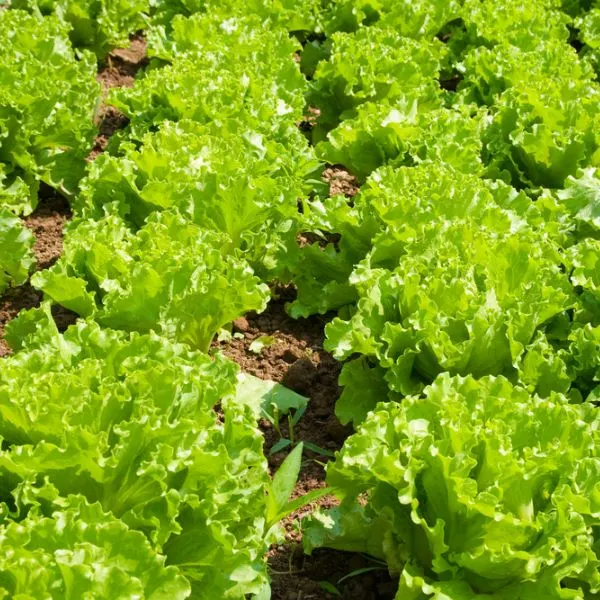
- Botanical name: Lactuca sativa
- Sun Requirements: 4-6 hours of full sun per day
- Soil Type: Well-drained soil, rich in organic matt
Looking for a cool-season crop that’s easy to grow? Try lettuce! This crisp and refreshing veggie comes in all sorts of shapes, sizes, and colors, from delicate butterheads to crunchy romaine. It’s a staple ingredient in many salads and sandwiches.
If you’re looking to improve your garden’s productivity and reduce pest infestations, you might want to consider companion planting lettuce and bell peppers. Despite their seemingly different characteristics, these two plants actually have a lot to offer each other. One of the main benefits of growing lettuce alongside bell peppers is that lettuce acts as a natural soil conditioner. With its shallow root system, lettuce can break up compacted soil and improve water and nutrient absorption, which is essential for bell peppers to grow and thrive. Moreover, lettuce’s high water content can help regulate soil moisture levels, ensuring that your peppers stay hydrated.
But the advantages of companion planting don’t stop there. Lettuce is also known to attract beneficial insects like ladybugs and lacewings, which can help control harmful pests like aphids and spider mites while serving as a natural trap crop for slugs and snails. Plus, lettuce provides natural mulch for bell peppers, which can help regulate soil temperature and prevent moisture loss. With its shallow root system, lettuce doesn’t compete with the deeper roots of the bell pepper plants, allowing them to coexist in the same soil without any negative effects.
In conclusion, growing lettuce alongside bell peppers can offer numerous benefits to your garden, from improving soil health to reducing pests and providing natural mulch. These two plants complement each other well, and their relationship in the garden can lead to healthier plants and higher yields. So, if you’re looking for an effective and natural way to boost your garden’s productivity, try planting lettuce and bell peppers together – you won’t regret it!
38. Parsnip
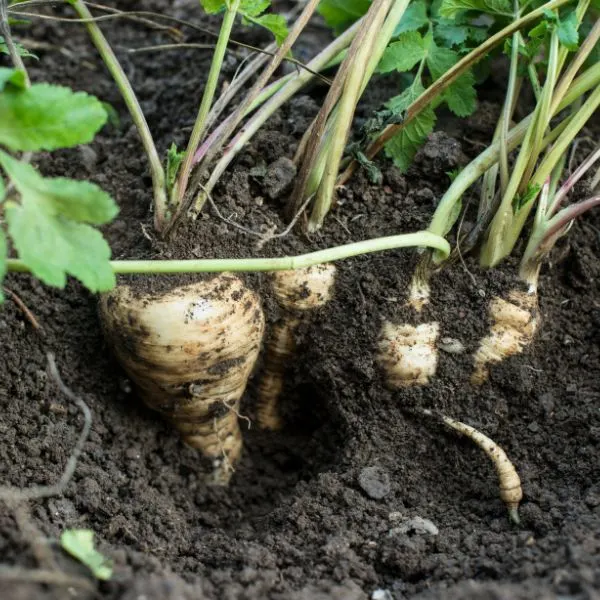
- Botanical name: Pastinaca sativa
- Sun Requirements: 4-6 hours of full sun per day
- Soil Type: Well-drained soil, rich in organic matter
Parsnip is a root vegetable that’s related to carrots and Parsley. Its sweet, nutty flavor and creamy texture make it a popular choice for fall dishes.
Are you looking to elevate your gardening game? If so, consider planting parsnips alongside bell peppers. Although they may not seem like the most obvious pairing, these two plants can benefit each other in several ways.
Firstly, parsnips have a unique root system that can improve soil structure and drainage, which is beneficial for bell peppers that require well-draining soil. Additionally, parsnips can help regulate soil temperature by being planted in the cooler months, preventing the soil from becoming too warm and damaging the bell pepper plants. Furthermore, parsnips produce beautiful flowers that attract beneficial insects like ladybugs and hoverflies, which can help control harmful pests that could damage the bell pepper plants.
In conclusion, growing parsnips alongside bell peppers has numerous benefits, including soil health improvement, pest control, and temperature regulation. So why not give it a try and see how these two plants can have a mutually beneficial relationship in your garden?
39. Pak choi
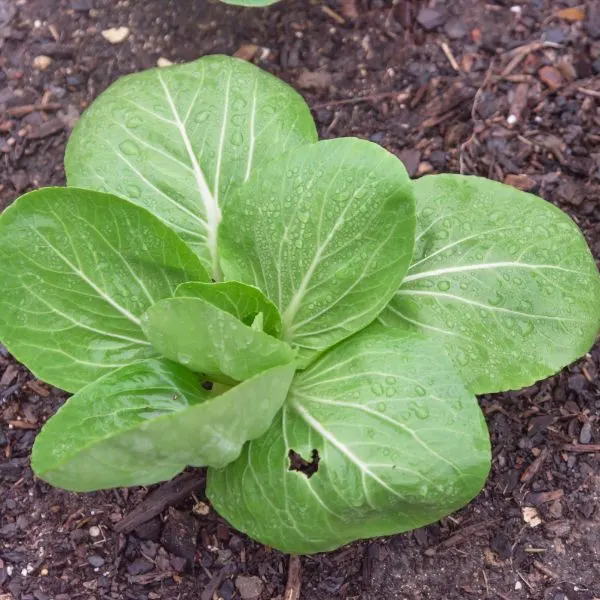
- Botanical name: Brassica rapa chinensis
- Sun Requirements: 4-6 hours of full sun per day
- Soil Type: Well-drained soil, rich in organic matter
If you’re looking for a leafy green with a mild, slightly sweet flavor, consider pak choi, also known as bok choy or Chinese cabbage. This fast-growing vegetable is easy to grow and can be used in stir-fries, soups, and salads.
Have you ever heard of pak choi? Also known as bok choy, it can offer several benefits to bell peppers as a companion plant. One of the best things about it is its ability to attract beneficial insects like hoverflies and ladybugs. These insects can help control harmful pests such as aphids and spider mites that can damage bell pepper plants. That’s pretty cool, right?
But that’s not all. Pak choi also has a shallow root system that can help improve soil health. It can break up compacted soil and improve soil aeration, which can promote better water and nutrient absorption for bell pepper plants. Plus, it can help prevent soil erosion and provide a natural mulch to regulate soil temperature and moisture levels. And here’s another thing: pak choi is a fast-growing crop that can be harvested relatively quickly. This means it can create space for bell pepper plants to grow and thrive. Its leaves can also provide shade for bell pepper plants during hot summer months, helping to regulate soil temperature and prevent moisture loss. All in all, growing pak choi alongside bell peppers can be a mutually beneficial relationship that improves the health and productivity of both plants.
So there you have it – pak choi can help bell peppers in several ways, from attracting beneficial insects to improving soil health to providing shade. It’s a great plant to consider adding to your garden!
40. Radish
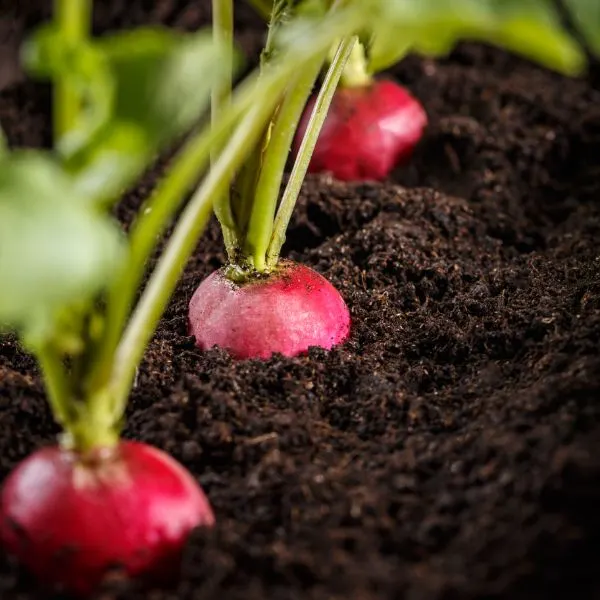
- Botanical name: Raphanus sativus
- Sun Requirements: 6-8 hours of full sun per day
- Soil Type: Well-drained soil, rich in organic matter
Finally, radishes add a slightly spicy flavor and crunchy texture to salads and sandwiches. With a variety of shapes, sizes, and colors, they’re versatile ingredients in the kitchen. Plus, they’re packed with vitamin C and other important nutrients, making them a healthy addition to any diet.
If you’re looking for ways to improve the health and productivity of your bell pepper plants, have you considered planting radishes alongside them? Here’s why it’s a good idea. Firstly, radishes can help break up compacted soil and add organic matter, which can lead to better water and nutrient absorption for bell pepper plants. They’re also great at preventing soil erosion. Secondly, radishes grow quickly and can be harvested relatively fast, creating space for your bell peppers to thrive. Radishes can also repel pests that may damage your bell pepper plants.
Overall, planting radishes alongside bell peppers can benefit both plants, improving soil health and repelling pests. While radishes create space for bell peppers to grow, bell peppers provide shade and help conserve soil moisture. It’s a win-win situation. So why not try planting radishes with your bell peppers this season?
Bad Companion Plants for Bell Peppers
1. Brassicas
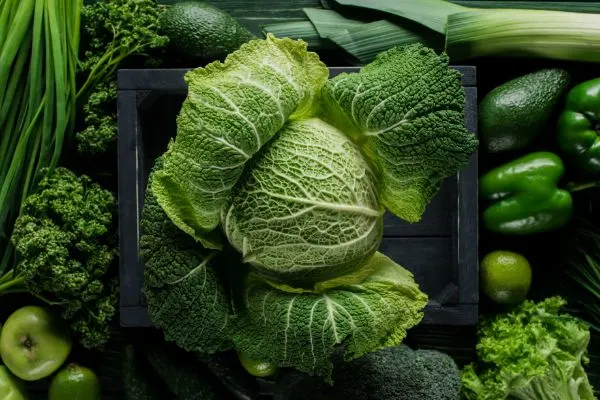
Brassicas, which include plants like cabbages, broccoli, and cauliflower, are sometimes considered to be bad companions for bell peppers due to their allelopathic effects. Allelopathy refers to the ability of some plants to release chemicals into the soil that can inhibit the growth or development of other plants.
In the case of Brassicas, they are known to release compounds called glucosinolates, which can have a negative impact on the growth of other plants, including bell peppers. Glucosinolates can break down into substances such as isothiocyanates and thiocyanates, which are toxic to some plants and can inhibit their growth.
Additionally, Brassicas are heavy feeders, which means they require a lot of nutrients from the soil. This can leave the soil depleted and make it more difficult for neighboring plants like bell peppers to thrive.
However, it’s important to note that companion planting is not an exact science, and there may be variations depending on specific plant varieties, soil conditions, and climate. Some gardeners have had success growing Brassicas and bell peppers together, while others have not. It’s always a good idea to do some research and experiment with different planting combinations to see what works best in your garden.
2. Corn
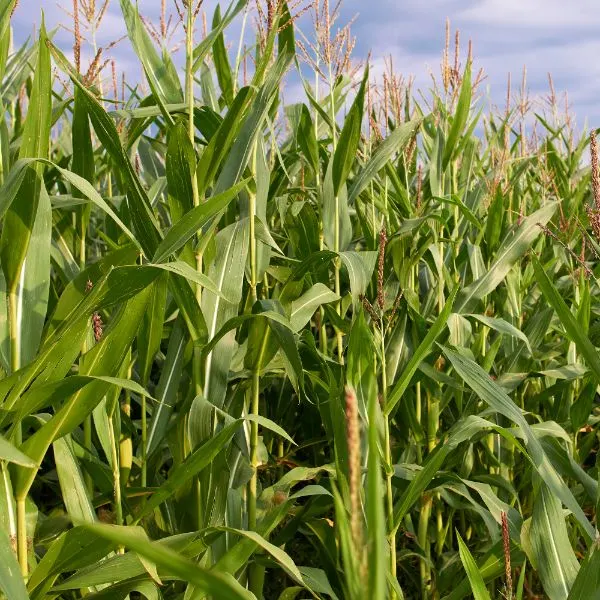
Companion planting is a technique gardeners use to grow healthy crops by strategically planting compatible plants together. Although it’s a popular technique, not all plants are good companions, and some can be harmful to each other. For instance, corn and potatoes may appear to be a good match, but several potential negative impacts must be considered.
Corn is a heavy feeder, meaning it requires a lot of soil nutrients, which can lead to competition between corn and potatoes. This competition can cause the potatoes to grow slowly or produce lower yields. In addition, corn may attract pests like corn earworms that may feed on the potato plants, resulting in an increased risk of pest infestations and damage to the potato crop. Furthermore, corn and potatoes are susceptible to blight and rot, which can spread between the two crops if they are planted too close together, causing significant losses for both crops.
To ensure the best growth and yields for both crops, it’s essential to plan the companion planting arrangement carefully when planting corn and potatoes together. By doing so, you can establish a thriving garden environment that promotes healthy growth and productivity for all your plants. Before planting, it’s crucial to research different companion planting arrangements and consider the individual needs of each crop. Keep in mind the potential negative effects and plan accordingly, and your garden will thrive.
3. Fennel
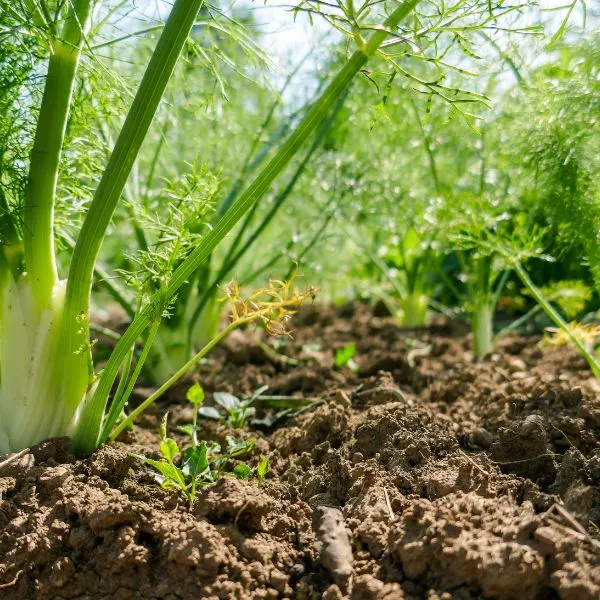
Companion planting is a popular technique used by gardeners to improve plant growth and health by strategically planting compatible crops together. When it comes to fennel and bell peppers, there isn’t clear evidence that fennel has negative effects on the growth of bell peppers. In fact, some gardeners even suggest that fennel can attract beneficial insects like ladybugs and lacewings that help control pests that may harm bell peppers.
However, it’s important to keep in mind that fennel can inhibit the growth of some plants, particularly those in the same family, such as dill, Parsley, and cilantro. This is because fennel roots release allelochemicals that can affect the growth and development of nearby plants. Therefore, it’s important to be mindful of fennel’s potential effects on other plants when planning your companion planting arrangements. By doing some research and careful planning beforehand, you can ensure that each plant has the best chance for healthy growth and productivity.
In conclusion, while fennel may not necessarily have negative effects on bell peppers, it’s crucial to be aware of its potential effects on other nearby plants. By considering the unique needs and compatibility of each crop, you can create a successful and harmonious garden environment that promotes the growth and vitality of all your plants. So, go ahead and experiment with different companion planting combinations, and see what works best for your garden!
4. Kohlrabi
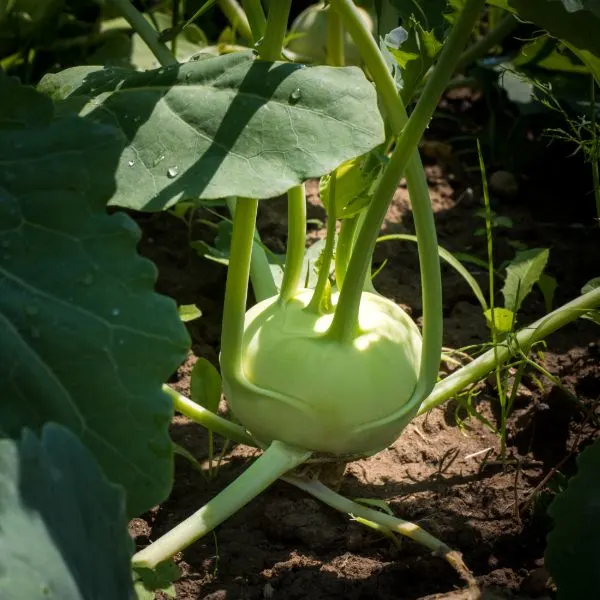
Companion planting is a popular technique among gardeners to enhance plant growth and health by strategically planting compatible crops together. Kohlrabi and bell peppers are two such crops that are often paired together. Fortunately, there isn’t clear evidence to suggest that kohlrabi has negative effects on the growth of bell peppers. In fact, some gardeners even suggest that kohlrabi can be a good companion for bell peppers since they have similar soil and water requirements.
Kohlrabi belongs to the brassica family, which also includes broccoli, cauliflower, and cabbage. Although some plants in this family release allelochemicals that can inhibit the growth of nearby plants, there isn’t much evidence to suggest that kohlrabi has significant negative effects on other plants. It’s important to remember, however, that every garden is unique and different plants may interact differently in various environments. Therefore, it’s essential to carefully plan and experiment with different companion planting arrangements to find what works best for your garden. By doing so, you can create a thriving garden environment that promotes healthy growth and productivity for all your plants.
5. Strawberries
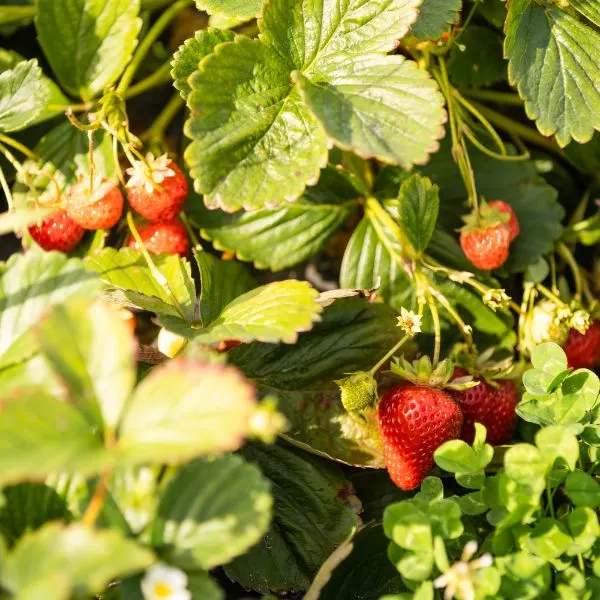
Growing strawberries and bell peppers together may not be the best idea. For starters, both plants can be vulnerable to a fungal disease called verticillium wilt. This nasty disease can lurk in the soil for years, and if one plant becomes infected, it can quickly spread to the other plant, leading to stunted growth and reduced yields.
Another problem that can arise is that strawberries have a way of attracting slugs and snails. These slimy critters can chomp on the leaves and fruit of bell pepper plants, leading to a lot of damage. Not good news if you were hoping for a bountiful harvest!
Lastly, strawberries and bell peppers have different soil and water requirements. Strawberries like slightly acidic soil that’s well-drained, while bell peppers prefer neutral soil that drains well. If you plant them together in soil that doesn’t meet the needs of both plants, you may end up with disappointing results. So, while it’s possible to grow these two plants together, it’s important to keep these potential issues in mind and take steps to prevent them from becoming a problem.
FAQs
How do I get my pepper plants to produce more fruit?
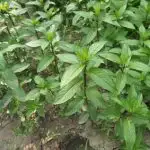
While in starter cups and soon after transplanting, gently pinch off flower buds to help the plant generate more growth before flowering. Pick peppers soon after they ripen. Regularly harvesting the plant’s peppers encourages it to produce more. If fertilizing, reduce nitrogen level once the plant begins to flower.
What fertilizer does bell pepper need?
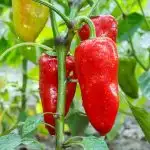
A complete fertilizer, like a 12-12-12 ratio, works well with California bell peppers. The nitrogen level needs to be the same or slightly higher than the other nutrients, commonly phosphorus, and potassium, for the best-growing results.
What is a homemade fertilizer for bell peppers?

One that is popular with many pepper farmers is Epsom salt fertilizer. Epsom salt consists of magnesium sulfate and has been used in gardening for centuries. Add Epsom salt to the soil before transplanting your pepper plants, and you can also use it in the form of a foliar spray.
What do you feed peppers when fruiting?

During the fruiting stage, plants need less nitrogen but plenty of phosphorus and potassium for the best yields. This can be achieved using an even-grade fertilizer all season or, ideally, by switching fertilizers halfway through the growing season.
How do you prune peppers for maximum fruiting?
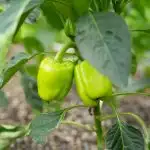
To top pepper plants, prune off all of the growing points about 3 to 4 weeks prior to the arrival of the first expected frost. This forces all of the remaining peppers to mature and develop to their full color. Use a pair of pruners to trim off the topmost 3 to 6 inches of every branch and side shoot.
How long does it take for a bell pepper to grow full size?
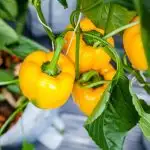
Peppers have a long growing season (60 to 90 days), so most home gardeners buy starter pepper plants at the garden nursery rather than grow them from seed. However, you can start pepper seeds indoors if you want to grow your own.
Do bell peppers need a lot of water?
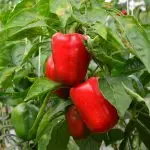
Bell peppers need deep watering, about one to two inches per week. Although bell peppers like warm weather, they will not flourish in intense heat, so gardeners in climates that are prone to higher temperatures should water twice a day if necessary.
Can you plant tomatoes and bell peppers together?
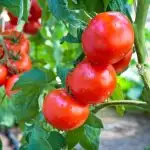
Yes, you can plant tomatoes and bell peppers together, as they have similar growing requirements and thrive in warm, sunny conditions.
Wrapping up
Bell peppers, also known as sweet peppers, are a delicious addition to any garden. These warm-season crops belong to the nightshade family and require proper care to ensure a bountiful harvest. In this article, we have explored Forty (40) Good companion plants for bell peppers, highlighting plants that can boost their flavor and also Five (5) Bad companion plants that should be avoided.
Growing bell peppers can be a fun and rewarding experience, but it’s important to keep a few things in mind to ensure a successful harvest. First and foremost, these sun-loving veggies need lots of light and warmth to thrive. So, choose a sunny location in your garden and wait until the threat of frost has passed before planting. And don’t forget to use well-drained soil enriched with organic matter to give your plants the best possible start.
Of course, no garden is without its challenges, and bell peppers are no exception. Flea beetles, hornworms, and blossom end rot are just a few of the pests and diseases that can pose a threat to your pepper crop. To keep them at bay, try rotating your crops regularly and practicing good garden hygiene. You can also plant herbs like basil and Parsley alongside your peppers, which can help deter pests and enhance their flavor. With a little care and attention, you’ll be rewarded with a bountiful harvest of delicious bell peppers that will make your taste buds sing
More companion plants
